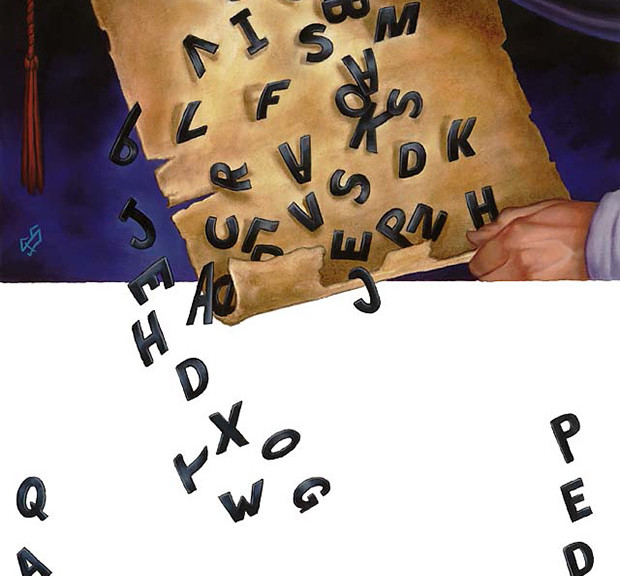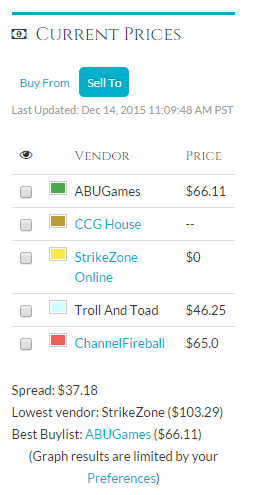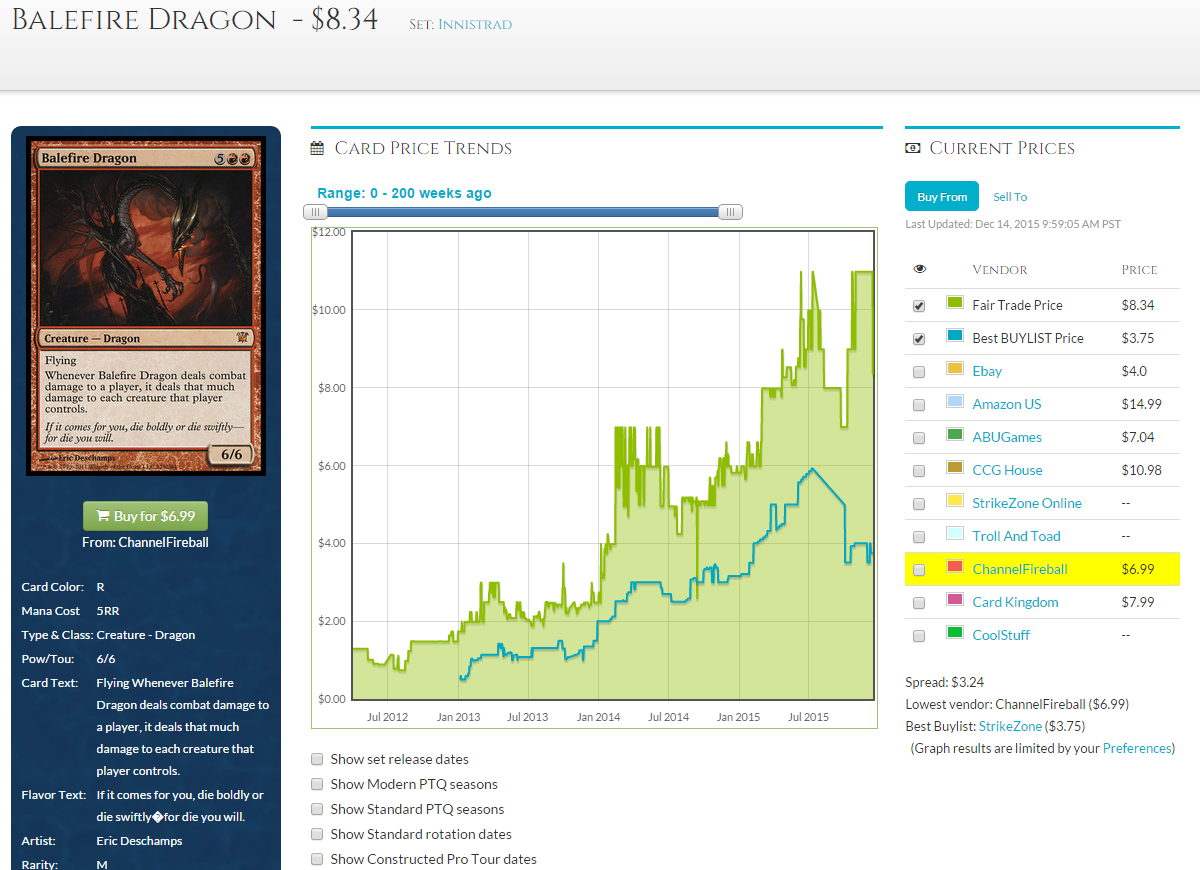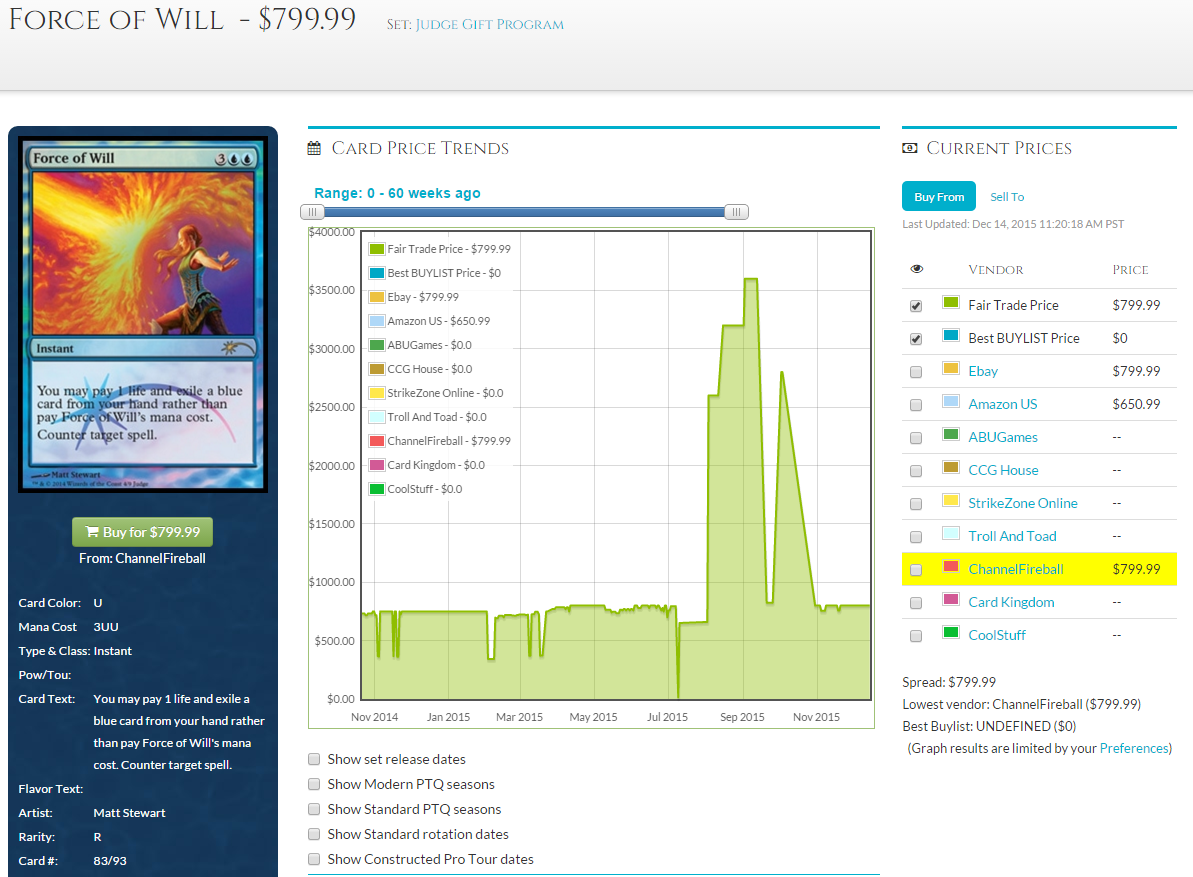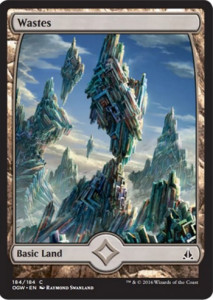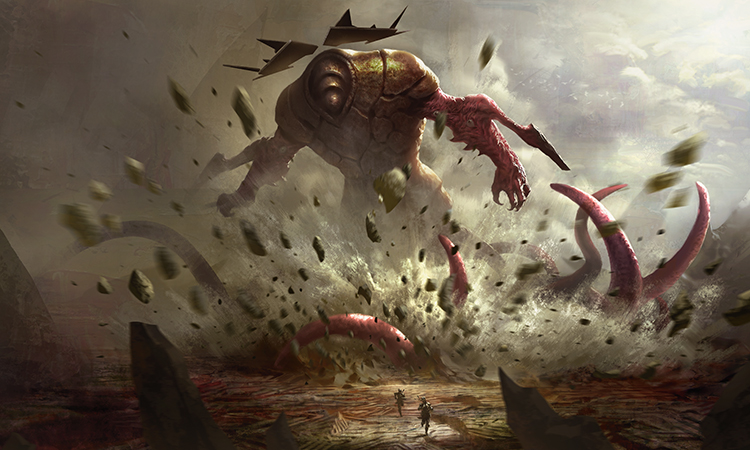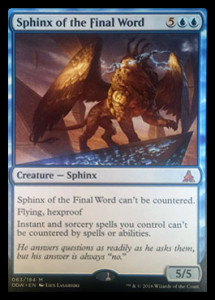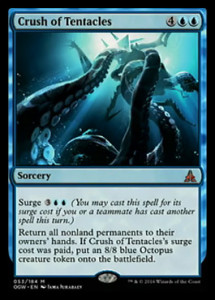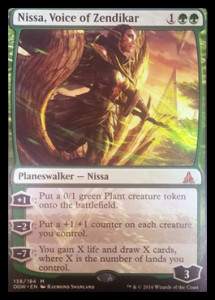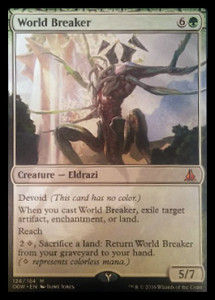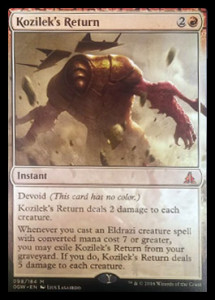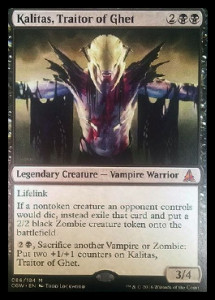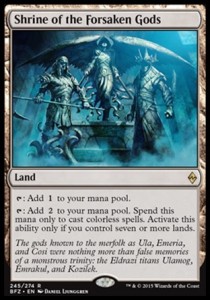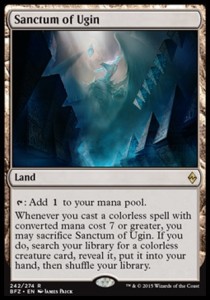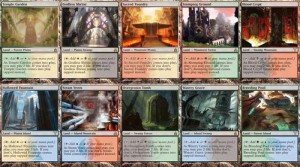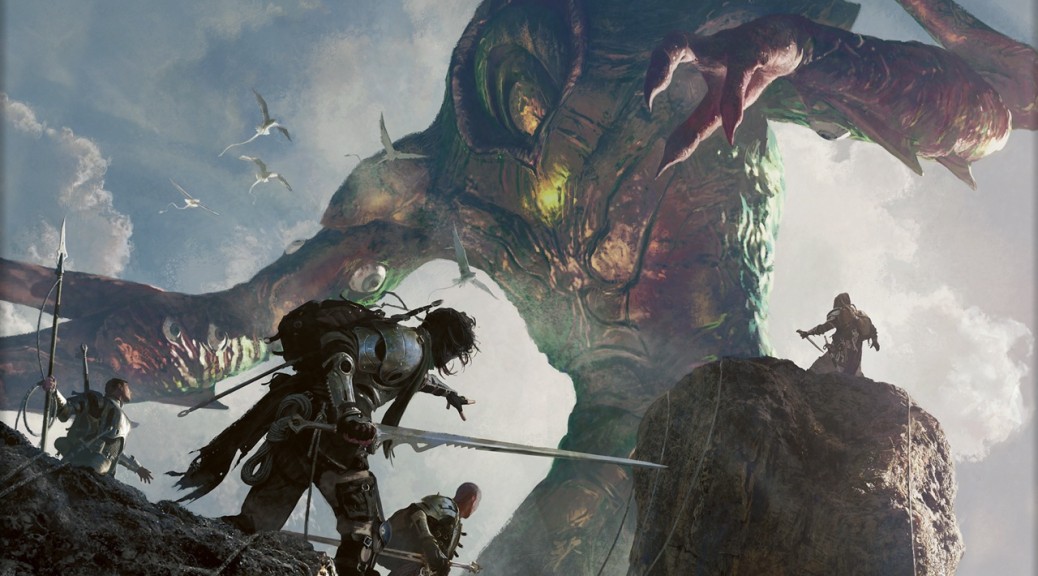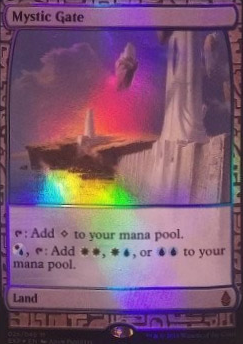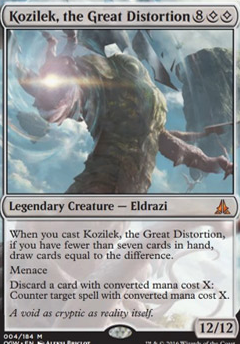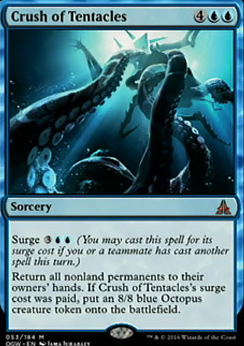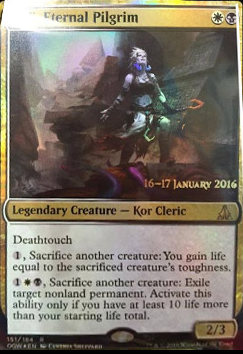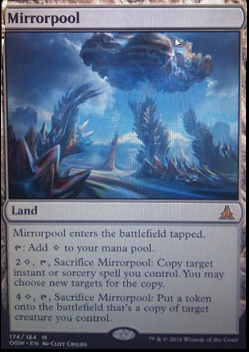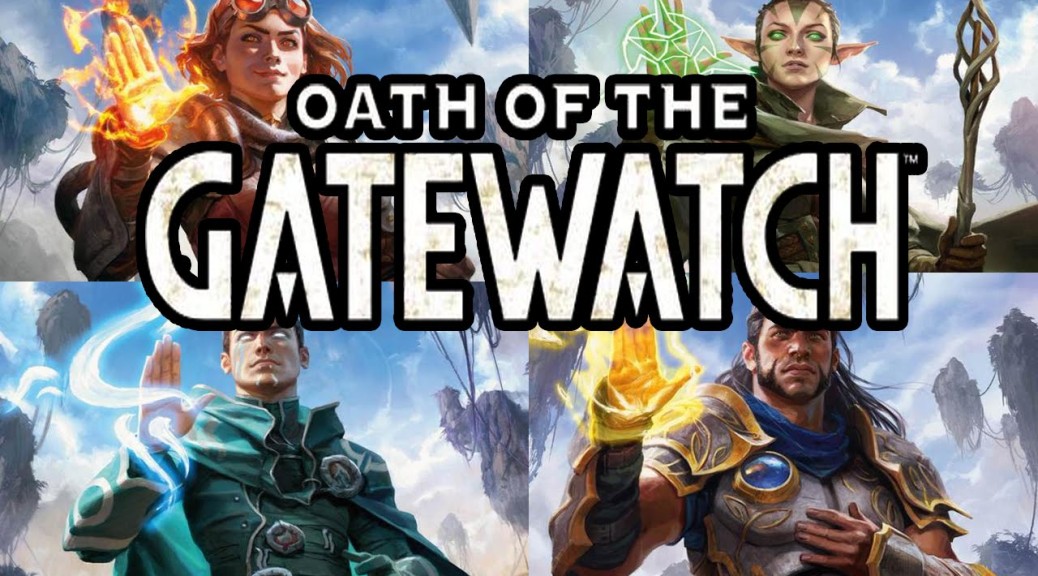What’s up, MTG Price fanatics? Oath of the Gatewatch will be here soon. Once again, MTG Price is your source for spoiler coverage. Get all of your updates and advice here, your favorite Magic the Gathering Finance website. Don’t agree with an assessment? That’s what the comment section is for. Think we’re killing it? Leave it there or e-mail webmaster@mtgprice.com to contact what I have to assume is Spider-Man. Let’s get into it!
While we were getting a bit of a trickle of information at first, someone opened the floodgates.
Before we discuss anything, let’s look at Battle for Zendikar fewer than 3 months later.

2 cards above $10 and only 16 above $2. Let’s remember that when we preorder.
1/8/2016
The set is fully spoiled. We covered every rare and mythic here as well as some commons and uncommons we think will be worth looking at from a finance perspective. Thanks for reading our coverage, keep the feedback coming and check prices every day. There are a few cards that are selling cheaper than DJ and I had anticipated so there are opportunities (potentially) if the cards take off in Standard or Modern or Legacy at all. Also, the list of cards in BFZ worth more than $2 just got a little bigger as Wasteland Strangler climbs to $3ish. Make sure to pay attention to the meta as it develops as emerging tech, this time in Modern, can push rares up from bulk. Prices are not set in stone and a lot can change them, so stay vigilant and keep coming to MTGPrice for the inside dope on what’s on the move and what’s poised to do big things.

Jason Alt – If you are playing an allies deck, getting a trigger is pretty saucy. If you’re playing weenies, getting a token is pretty saucy. Lots of EDH decks will want this and those same decks are already tutoring for equipment. This isn’t the most exciting equipment in the set for EDH by any means, but this could theoretically impact other formats. I still see this as a cheap if not bulk rare, but I like the effect.
DJ Johnson – the General Tazri deck probably wants this, but I don’t think that makes it a non-bulk rare. Forcibly sending a 1/1 into battle isn’t always the best idea, so you can’t even keep the token back to block and win trades while attacking with the equipped creature. I don’t think foils of this hold any premium, even though its’ primary draw is in a couple different Commander decks. Sell as soon as possible, and don’t hold onto these hoping they’ll go up.
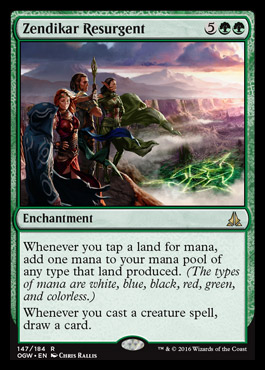
Jason Alt – Sweet Gideon’s jockstrap. This card is bugnutty. Buried toward the tail end of the spoiler, this card has the gas to really climb the price charts longterm. Initially probably a bulk rare, I’m going to get every copy of this card I can get my mitts on. If it does start out at $4 or more, don’t worry, it will dip at peak supply. Unlikely to get played in Standard, this is EDH gold. While not quite as strong as Mana Reflection (a $19 card) this does have the added benefit of having a built-in card-drawing engine for when you cast spells. I want every foil of this I can get my hands on. This won’t replace Mana Reflection in every deck that runs it because it doesn’t double the mana nor does it allow mana from any source to double but this does a lot of work regardless, only costs 1 more mana, and has a great second ability. If you’re playing a deck like Maelstrom Wanderer, this card is perfect. I love, love, love this card. I think the price trajectory of Dictate of Erebos is going to be a good one to watch to figure out when to buy in, provided people don’t catch on right away and overcharge for this at prerelease. This won’t be $19 but it won’t be bulk, either. EDH will see to that.
DJ Johnson – Looks like Jason and I disagree again here, so you’ll get some healthy discussion from multiple viewpoints instead of both of us just telling you whether we think something is good or bad. I honestly don’t want to play this in any of my decks over Mirari’s Wake or Mana Reflection. While the latter certainly deserves its’ $20 price tag due to a combination of low supply and uniqueness (doubling non-land mana sources), I don’t think this gets there as a non-bulk rare in the short term, so at least Jason and I agree there. . Maybe I’m wrong, but I think this just comes out a little too late compared to the other mana-doubling enchantments. The card-draw on the creature casting is certainly nice, but it just seems win-more to me. I’m perfectly happy selling these all day at $1, and I don’t feel like waiting three years for it to creep to $2.
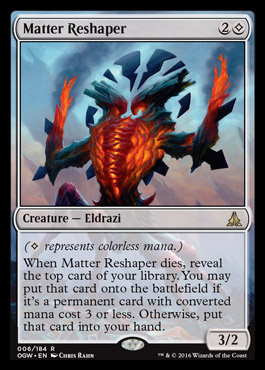
Jason Alt – I have seen a lot of positive buzz around this card that I don’t agree with, mainly concerning Modern. You don’t want to tap out on turn 3 in a combo format hoping to flip this into something good, you want to just cast something good, I think. This has a better chance of seeing play in Legacy where you’d rather just cast Shardless Agent. I think this card is overrated and even though its effect can be good, it can also be bad and it remains to be seen if someone can concoct a deck that wants to play this, something I’m unconvinced will happen.
The reddit spikes are bearish on this as well.
DJ Johnson – While the percentage of times you’ll hit off this are probably pretty high (it does hit lands), I don’t think this is something that’s going to be broken in Eternal formats. Maybe it sees play in Standard with Collected Company? Even so, I don’t think that merits a price of more than a dollar or so. I’d stay away from these and be happy shipping them to anyone who thinks that it’s going to be broken in Modern or Legacy, or I’d be happy trading for them at $1 if I was a Standard player expecting to sleeve these up in some value-midrangey-green deck.
1/6/2016
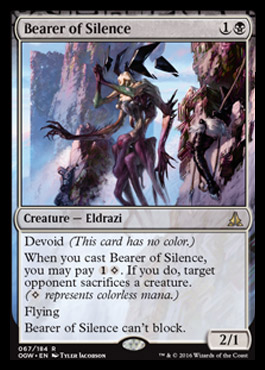
Jason Alt – Just put kicker on the stupid cards if they have a kicker ability. You already have 14 stupid keywords in this stupid set, just put kicker. Or put surge on this. How hard was that? I just made the card more interesting. Creatures can have surge, why not? Explore your stupid design space instead of just explaining an old keyword. They assigned keywords to a ton of old effects that never had them like rally for this set and then they did the opposite here. Ugh.
The card itself is fine, I guess. It’s a devoid, more expensive Gatekeeper of Malakir and that makes it rare for some reason. Maybe because it still works if they counter it? Why can’t it block, though? I hate this card and I think it will probably be a bulk rare. Expensive removal stapled to a creature is typically at uncommon but it’s also typically playable so we’ll see if this is playable enough to break the $2 mark.
DJ Johnson – I keep telling myself this is a bulk rare, but I just have a feeling that it could be powerful. If this does become bulk, I’m happy picking them up at quarters and dimes and holding onto them instead of selling at $.50. If there’s a black aggressive strategy in Standard, this can fit right into it. I feel like this would go really well with Drana, but I’m no brewer. Stay away until it hits bulk though, unless you know something I don’t (entirely possible).
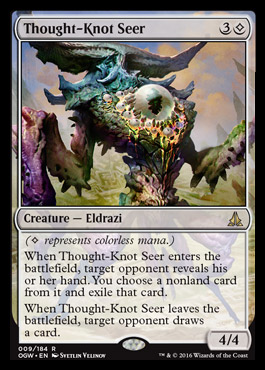
Jason Alt – This card is sweet and it’s even better in EDH. You can flicker this and strip one person’s hand and fill a different player’s up. This is a decent body on this effect which means it won’t die as easily meaning that card likely doesn’t get replaced for a while. I like this a lot and people are really excited. This could be a few bucks if people play it in some sort of midrange Eldrazi deck like the one in Modern since EDH and cube are already pretty excited. This has a lot of chances to experience upside.
DJ Johnson – This card is sweet, and it’s even better in Modern. I hear a lot of talk about this getting played in the Eldrazi deck, crippling an opponent’s hand after (or before) a Thoughtseize/Inquisition. If you don’t leave them with any ways to answer it, the card they get rewarded with for killing it ends up not mattering. While I wouldn’t pre-order these expecting a spike, I don’t hate you for trading into them or picking up your copies to play with. They saved a lot of powerful cards for the last few days of the spoiler, and this is one of them.
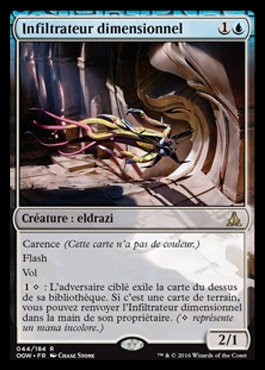
Dimensional Infiltrator
1U
Devoid (This card has no color.)
Flash, flying
1◊: Exile the top card of target opponent’s library. If it’s a land card, you may return Dimensional Infiltrator to its owner’s hand.
Jason Alt – This is a weird sort of Frenetic Efreet variant, but I kind of like it. It has a chance to not die but you can also use it to try and mill them out. I really can’t see this getting a ton of Standard play which means its price is really limited, but it’s still fun. The thing is, you don’t really want to exile lands from the top of their deck, so it seems odd to help them for the privilege of recasting your small creature.
Spikes aren’t thrilled.
DJ Johnson – I like weird designs like this. It’s all over the place, although I don’t think we’ll have a blue tempo deck that this type of card thrives in. This wants a Delver style deck that we don’t have, so I expect this to shrivel up and become a bulk rare. Feel free to sell or trade these to anyone who thinks that the unique ability and respectable combat stats will encourage it to become a force in Standard, because I don’t think you’re losing out by getting rid of them.
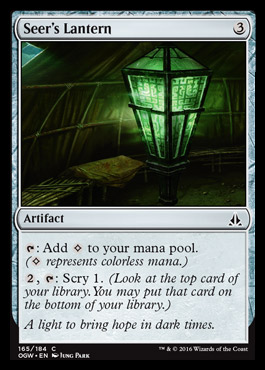
Jason Alt – This could replace Crystal Ball in some decks, but I’m not sure how many. Scry 2 is more than twice as good as Scry 1, if you ask me, and it all comes down to whether you think you will want some sources of colorless badly enough to take out Crystal Ball. Scry 2 is very good, but so is activating Endbringer. So this could replace Crystal Ball half the time and Crystal Ball is in 3% of the decks on EDHREC. Even foils aren’t super exciting, but they are still going to go up when this card catches on a little, I think.
DJ Johnson – I don’t think this replaces Crystal Ball. You’re paying more mana every turn for less of an effect, and it competes with hundreds of other mana rocks that do the job better. If you’re playing Crystal Ball, you really need that extra dig power and you’re not looking to split hairs by trading for a mana rock. This is rock number 748, but if you really want to hedge on the safe side then keep foils tucked away somewhere. Just don’t be spending cash on them.
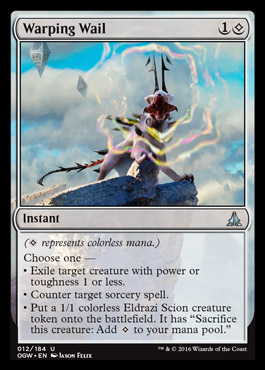
Jason Alt – This is premium removal is Legacy and Modern if you can cough up the mana for it. This kills a lot of tough and annoying creatures. Being able to counter a Sorcery on top of it is really saucy. This basically staples two sideboard cards together so well it’s maindeckable. I imagine this is a few bucks and even more in foil. Everyone is very excited about this card and with good reason.
DJ Johnson – Jeez. Snapcaster, Deceiver Exarch, Stoneforge, Deathrite Shaman….. This kills so many things, and being an Envelop is just icing on the cake. This card is extremely powerful, and it will find homes in more than just Standard. SCG is preselling these for $8 a playset, and I don’t blame them. I think is going to be worth money for long after the set rotates out of Standard, so get your copies now if you plan on playing with them, unless you’d rather try and trade for them at the pre-release. Foils will also hold a high multiplier as long as this finds a couple of homes in the Eternal formats that a lot of players believe its’ strong in.
1/5/2016
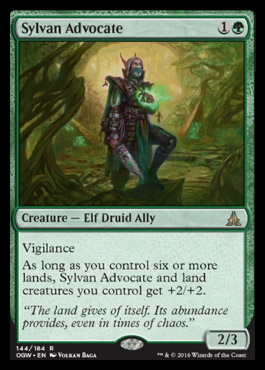
Jason Alt – One of the only creatures with landcraft, this seems OK to me. It’s Goyfy enough to get serious consideration, although this isn’t a 4/5 on turn 3 or 4 like Goyf is as often. There isn’t the right kind of mana ramp in Standard to get to the requisite lands fast enough. This is an excellent inclusion in ally decks, though. The ability to boost your manlands and Awakened lands could give this a boost also. It has a lot going for it, but I don’t know if it’s too slow for Standard. Usually when something is compared to Tarmogoyf people laugh and while this has the potential to be a big body for 2 mana, it takes way longer than Goyf does and your opponents’ stuff doesn’t count towards it, either. I’m inclined to take a gamble on this if it presells at a few bucks, but if this comes out of the gates at $6, that’s a little too much risk for me. Evaluating cards is tricky and the Spikes subreddit seems split on it. Read what they have to say.
DJ Johnson – Wait, this is an Ally? It certainly has the stats to see play in Standard, although whether it finds a deck or not is up in the air. We just don’t have the ramp that we used to, and spending spells on ramp means that you’re not applying pressure with other creatures. That leaves you with a lot of mana and a 4/5, but your opponent is still at 20 life so you’re trying to do two things at once. Whether it sees play in Standard or not, there’s definitely the “what-if” factor to make sure that it doesn’t go to true bulk. I’m always hesitant to buy into pre-sale prices, so I’d rather stay away for now.
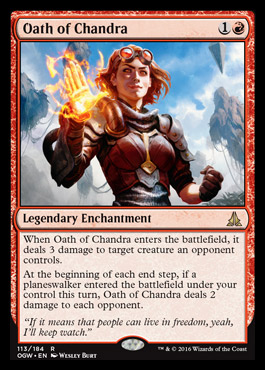
Jason Alt – Seems like a bad Roast. Draconic Roar is probably a better choice since it pairs with dragons but if you want to play Planeswalkers and not dragons, this could be your card. This just feels like the worst one in the cycle so far. I’m pretty underwhelmed. This doesn’t help you cast Planeswalkers or make them better but rather makes your clock faster which Planeswalker decks don’t really seem to care about. You play a Planeswalker to have a threat they much answer and win by the overwhelming amount of advantage they provide, not because they’re good curve-toppers in a burn deck. I don’t think I like this at all. The spikes sub seems to concur.
DJ Johnson- What does Wotc have against Chandra? She always gets the short end of the stick when it comes to Standard playability, and the ‘Walker trigger is neither immediate or board-changing. This is definitely the worst Oath we’ve seen so far, and I don’t even think the 5c ‘Walker deck in Commander wants to touch this card. Go back to playing Roast or Dragonic roar in standard. On the plus side, Chandra always gets the sassy flavor text for being hot garbage in terms of power level. “Eh, I guess I’ll help with this whole watch-keeping thing if it means that I get to throw fire at stuff.”
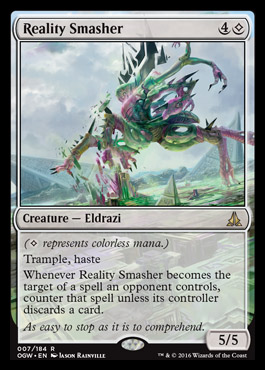
Jason Alt – This seems really hard to deal with. Trample and Haste means this card is a threat immediately. He dodges a lot of the removal in Modern and the removal that does hit him is a two-for-one. He doesn’t die to topdecked targeted removal. He doesn’t die to Siege Rhino. He smashes reality right in the face. There aren’t many rares in Battle for Zendikar worth more than $2 but Oath is a smaller set and this could get up to $5 if it’s as good as everyone thinks. Spikey players seem really hyped about it. Not just that, the EDH subreddit seems willing to try it in quite a few decks. This could be one of the gems of the set. I’d be willing to buy a few copies under $5 to see if the hype is substantiated.
DJ Johnson – Wow, it looks like they actually were saving the power level for later in the spoiler season. This is a card that is not to be underestimated, and it reminds me a lot of Thundermaw Hellkite from a “shut up, you’re taking damage this turn” perspective. It will always be a 2 for 1 for the control deck trying to deal with it through targeted removal, and trying to Ruinous Path this only for them to slam down another one immediately after seems just backbreaking. This is the card that makes painlands worth playing solely for the colorless. This card makes you want to find a source for true colorless. Buying a playset at $15 on eBay at presale actually seems fine if you’re a Standard player who wants to smash faces. On the other hand, don’t buy a playset at $15 expecting this to be a $8 chase rare throughout its time in the format.

Jason Alt – There is a huge power difference between this with surge and without. The last time we saw a card like that, it was called Bonfire of the Damned. This is closer to Crater’s Claws that Bonfire, for sure, but this can be a 2-for-1 if you have the mana to play a spell to trigger surge and get X high enough. You need enough mana to kill the biggest of the two creatures but the upside seems worth it. I don’t really know how to feel about this card, frankly. I’m inclined to say it won’t see much play but Crater’s Claws surprised us all. I don’t think it’s worth much money, either way and if it is, it will likely tank first. Even Bonfire did that.
DJ Johnson – Oh my God, this card is absolutely backbreaking in 2HG. You basically just auto-win the game if you draw it in a 2HG scenario, because you get to target each opponent separately, and double the damage. So you let your teammate cast a spell to trigger Surge, then you cast this by paying six mana for X = 5, targeting Player 1 and Player 1. That’s 10 damage to the dome for 6 mana, with the versatility of instant speed, the ability to target creatures, and split damage however you want.
Oh, right. Standard review and all that. I think this could actually seen some play. The only cards we’ve seen so far that appear specifically designed to enable Surge are Bone Saw and Oath of Nissa, and this doesn’t go in the same decks as those. However, I think the versatility previously mentioned more than makes up for it. It’s preselling at $8 a playset on eBay, and I think that’s more than fair if you want to cast them. It’s interesting to note that these seem alright as a 4-of, because you can use one to proc the others’ Surge cost in an emergency by declaring X=0 on the first, then using the second as a powerful instant speed removal spell or face-burner.
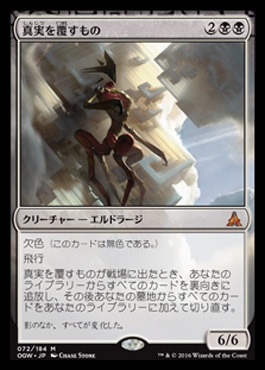
Devoid (This card has no color.)
Flying
When Inverter of Truth enters the battlefield, exile all cards from your library face down, then shuffle all cards from your graveyard into your library.
Jason Alt –This is a weird card. I didn’t expect another mythic to be spoiled which is cool. I don’t know how to feel about this card, unless I’m trying to win with Laboratory Maniac, I guess. While you could use Delve cards to sculpt your graveyard and stack your deck with sicko removal spells and fat creatures, you would need to be late in the game to do that. If you have 5 or 6 cards in your yard when you cast this, that may give you enough turns to go aggro. This is the same rate as Desecration Demon but it’s terrible in multiples. It’s well costed but I’m on the pessimistic side of the fence. Spikey players seem split. If this does take off, it could be hard to know how much it could be worth since it’s not great as a 4-of in the deck necessarily. It IS a mythic, though, so anything can happen. This also has the potential to get a bump after Khans block rotates and we look at this block again.
DJ Johnson – Woah. I love the design of this thing, and I’m really surprised that they didn’t spend the design space on a Demon. This reminds me a lot of Desecration Demon were it could go down to $1-3, then suddenly spike out of control if it finds a home in Standard. You’ll be gambling if you buy in because you’re betting on what Standard will look like 12+ months from now, but everything about this card screams gambling already. Either way, it’s really interesting and hard to predict. If you know one way or another whether this will be garbage or a staple, then you’re wrong. I’m suggesting to hold off buying at presale just to be on the safe side, but I wouldn’t be surprised if this found a home at some point in its’ Standard life.
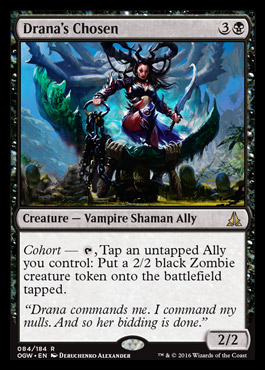
Jason Alt – This card is likely slower than I think it is and I think it’s pretty slow. On turn 5 this stops being summoning sick and then if you have another ally, you can tap it and this to put in a tapped zombie that will untap on turn 6. This doesn’t make a surprise blocker in combat, it doesn’t make a big enough creature to really threaten them, it doesn’t make an ally. Cohort is a bad ability, I think, and this is a bad example of it making it a bad card. Stay away. This looks even worse in EDH where you have cards like Cemetery Reaper to compare it to.
DJ Johnson – Bulky bulk rare is bulk. I didn’t even know that the Token came in tapped until I read Jason’s review. This shouldn’t make the cut of any Commander deck ever, unless you’re absolutely desperate. You can’t even tap non-Allies to get the creature in a Meren deck or something.
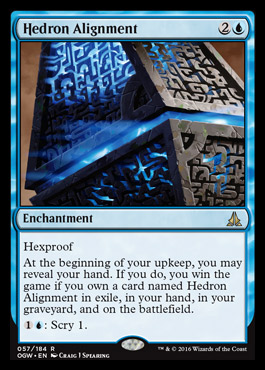
Jason Alt – A casual card that can’t be played in EDH? Sign me up. I am generally in favor of cards like this that are tough to win with but provide a nice deckbuilding challenge, but unlike The Cheese Stands Alone, this isn’t EDH-playable, even with cards like Copy Enchantment to try and get there. This is a bulk rare, which makes me sad. Biovisionary is a cool card and I wish this were equally cool.
DJ Johnson – I find it funny that people are seriously brewing with this card for Legacy, because it shows a lot of synergy with Intuition. You put one in your hand, two in the graveyard, then it’s easy to exile one from the graveyard with any number of artifacts or Delve costs to just put you one Exodia piece away from a handshake. (Sorry, I just started rewatcing the original Yu-Gi-Oh! series on Netflix). It’s easy to pitch to Force of Will or Misdirection, and Legacy has an interesting number of ways to tutor it up while trying to win. I’m not saying that this will be anything above a bulk rare, but I can almost guarantee some SCG pro is going to lose a bet and build a Legacy deck around this at an open someday.
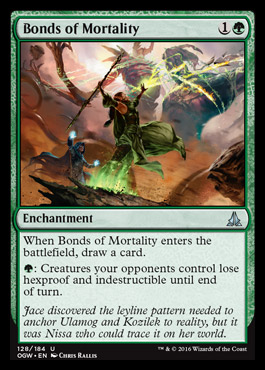
Jason Alt- This is going in a lot of EDH decks. Get foils if you can for cheap. People are very excited about this card.
DJ Johnson – I was about to call Jason an idiot and dismiss this, but then I reread the card. That helps sometimes. I initially though you had to sacrifice it to gain the Arcane Lighthouse effect, but you uh, don’t. Sorry Geist of Saint Traft/Uril the Miststalker/Sigarda, this card is absolutely bonkers. It’s still probably a true bulk or fake bulk rare, but it’s still a powerful card that will have demand from a lot of Commander players. Like Jason said, foils will be hot.

Jason Alt – Foils of this card are likely good for EDH, so be on the lookout.
DJ Johnson – As a representative of the Golgari Swarm, I really don’t think this card is all that great. You’d rather play Greenwarden of Murasa in the slot, and the six-drop slots are mostly taken up by other big fatties like Grave Titan. Maybe the foil will be worth a couple dollars, but I don’t think this card is good enough to earn a slot in any decent deck.
1/4/2016
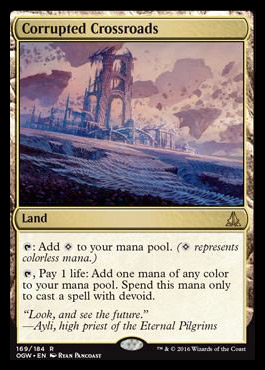
Jason Alt – They must have gotten all of my letter where I said “Please print a narrow Mana Confluence that is only good for exactly one set then make 14 lands just like it so the rare in every pack is a stupid land that’s only usable in Limited” because I said that.
DJ Johnson – I’m really annoyed that they neutered this card so hard. They could have let you use the mana of any color towards any colorless spells, or abilities of colorless permanents. That would at least make it interesting for Sunburst decks, and make it cute with Door to Nothingness. Oh well. Bulk rare.
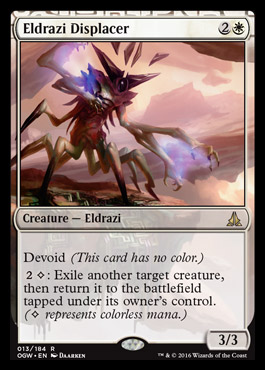
Jason Alt – This is very good. This is a mistmeadow witch that doesn’t force you to play blue (you’re probably already playing blue, though, aren’t you?) This pairs well with Sun Titan and Sun Titan brings this back. I don’t see non-foils doing anything short-term, but foils will likely go fast. This is a real EDH card and while it remains to be seen how likely people are to monkey with their manabases to produce true colorless more consistently, we already know there are a ton of decks like Brago and Roon just waiting to do dumb stuff with this card. We may see EDH players get impatient and move in on these in a hurry. This is a white Deadeye Navigator only it can be used to tap the opponents’ creatures in a pinch. This is very exciting.
DJ Johnson – Jason called this the most relevant Commander card in the set, and I’m inclined to agree. This is extremely versatile, and can blink their creatures while returning them tapped for an alpha strike. You’re probably going to play this to abuse enter the battlefield triggers in a deck like Brago or Geist of Saint Traft, but you can get a massive amount of value by going for the long game with Sun Titan, which just oozes value. If you can produce enough coloreless to activate this repeatedly every turn, it’s going to put the game out of reach. While I don’t think this is worth more than $1-2, the foils will definitely be worth keeping an eye on.
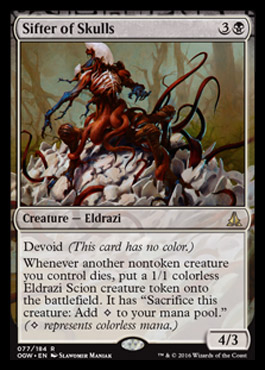
Jason Alt – This seems very good, also. I would like to see a Standard aristocrats list materialize since saccing creatures isn’t as punishing with the processors to mulch your dead friends. Zulaport Cutthroat is a juicy card and I want to find some way to exploit it in Standard. This is fine in EDH, I guess, but I feel like we want something like Fecundity in this spot, maybe? I don’t know. If you’re doing Grave Pact Shenanigans, saccing a dude and getting a trigger and the dude being replaced by a Scion you can also sac for another trigger seems fun. A lot of decks might want to try putting this in, but taking something out has always been the hard part and what do the decks that would jam this take out?
DJ Johnson Blood Artist makes me happy. This card makes me happy. I really want to find a spot for this in Savra, but the card and tokens being colorless hurts that deck in particular quite a lot. However, this definitely looks powerful to find a spot in Meren, and probably earns the spot over the Fresh Meat/Caller of the Claw Eldrazi that was spoiled earlier. I don’t think that this ends up being worth more than a dollar and it could definitely be a bulk rare, but unplayable this is not. We’re in the same category as Restoration Eldrazi right above us; $1-2 non foils, with shiny copies worth significantly more.
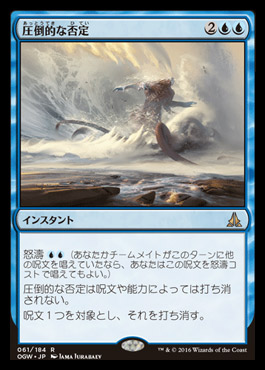
Surge UU (You may cast this spell for its surge cost if you or a teammate has cast another spell this turn.)
Overwhelming Denial can’t be coutered by spells for abilities.
Counter target spell.
Jason Alt – This does not seem good to me. Maybe I am being pessimistic and maybe my pessimism is colored by all of the things I hear being said in defense of this card and how wrong they are. No, Legacy likely does not want this. 1 or 2 Legacy lists have been known to run a copy or two of Counterspell but being uncounterable doesn’t make up for how clunky this is, I don’t care if you’re counting on Brainstorming into it. No, this is not good with Snapcaster Mage. You can’t pay the Surge cost if you give the spell Flashback. You can pay 4 mana for the spell plus two for Snapcaster. That’s a terrible 2-card combo that costs 1 more mana than hardcasting Force of Will, and not a reason to be excited about this card. We have had uncounterable counters before. No one cared then, either.
Spikey players seem to mirror my sentiments so far.
DJ Johnson: Ugh. Last Word this is not, and at least that card is $1 or so. They really don’t want two mana counterspells to be powerful, or playable in the early game at any level of consistency. Maybe things would have been different if Wotc had been designing Oath of the Gatewatch in 2009, but we’re six years past that and we’re acknowledging that this is a bulk rare.
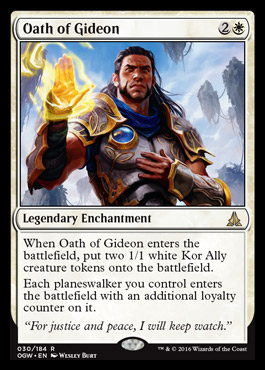
Jason Alt – I have seen a lot of EDH players excited by the prospect of flashing this out and returning it to play for value and I’m not sure how excited I am about doing the same. Planeswalkers entering with an additional counter is certainly interesting and this is a nice 1-2 punch with Gideon in Standard, I suppose. Still, I feel like there have to be better ways to Raise the Alarm. I don’t know what to do with this card. EDH players who want this will most likely be building a Superfriends deck and I don’t know if there are enough of those people to make this do anything but go down in price as weeks go by. I want to like this more than I do, but I don’t know why. If I’m wrong, tell me why.
This is what the EDH subreddit has to say.
1/1/2016
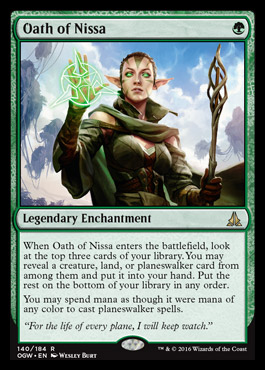
DJ Johnson – HA! That was my first time writing out 2016, and I didn’t screw it up and have to backspace. We’re off to a great start in the new year. Speaking of great starts, this card seems absolutely insane on turn 1. Someone should (and will) correct me if I’m wrong, but this seems really strong. The second ability probably isn’t relevant at all in Standard because we already have rainbow mana everywhere, but did we just got our first decent one mana cantrip since…… Thought Scour? I don’t know. I don’t even know how much these are pre-selling for, because our spoilers come hot off the presses, and there aren’t even any eBay auctions up yet. I think this card is very powerful and playable in Standard, but I still wouldn’t pay more than $2 a piece out of the gate(watch).
Jason Alt – Like so many cards, this is entirely dependant on its ability to find a deck, and most likely, a deck in Standard. A non-mythic rare in the post-mythic era in a set with Expeditions is going to have to do its best “Little Engine that Could” impression to get over $1. With MODO not being any fun to play and continuing to be a frustrating experience, MODO redemption costs being at an all-time high, Expeditions muddling things and it being easier than ever to get singles from a ton of sources, there may be nothing enforcing the cost of a set which can depress a lot of rares without making a mythic go way up to compensate. Expeditions are pulling most of the weight despite being a lottery ticket more than an insert you can trust. I guess what I’m saying is I don’t like this for any presale price unless it’s a 4-of in multiple decks in Standard. I like this a lot but I am not sure I see it. Green Ponder has legs, but I don’t know if they’re long enough.
However, if you see people talk about running this as a 4-of in Abzan or something, there is money to be made here.
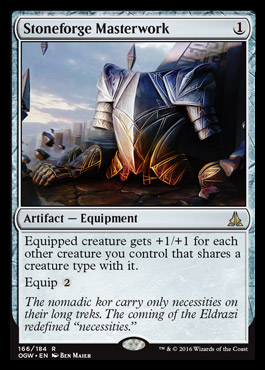
DJ Johnson – Alright. So we’re paying 60% of the cost of Coat of Arms, and getting a fraction of the effect. While Coat is worth $8 even with a billion reprints, I don’t think we’ll see that kind of growth in this card. We don’t want to spend our early turns in a Tribal deck playing equipment, we want to play out the cheap creatures so that we have a critical mass when its’ time to play Coat on turn 5 or 6. This screams bulk rare to me, since its’ definitely not going to see play in Standard or Modern. There’s just infinitely more useful pre-existing Tribal support in Commander, so I don’t think we need to spend our time and mana going wide and tall at the same time. These will be dimes in a short amount of time, and I think you’ll be hard pressed to find anyone looking for them.
Jason Alt – I think DJ’s off base, here. This card is the shiznit in quite a few decks and does a decent impression of Coat of Arms in a lot of others. The thing to remember is that you can tutor this up. Slam this on a Kemba and watch the game win itself. The important distinction between this and Coat of Arms is that you can grab this with a Stonehewer Giant or Godo, Bandit Warlord and you can copy it with Masterwork of Ingenuity. White tribal decks won’t bat an eye when it comes to getting this every single game. That said, I wrote an article this week you should check out about what EDH can’t do to prices, and EDH can’t move the needle on non-foils of these and Standard and Modern won’t care about this card. Foils of this have potential – we’ll have to see if it’s under a 5x multplier initially, but non-foils will be bulk, pretty much irrespective of its playability and that’s just how it is with EDH cards.
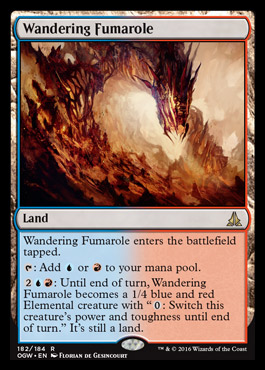
DJ Johnson – And here’s the Izzet manland. There was a lot of worry that it would be a functionally identical creature to Izzet Keyrune, and I’m glad to see that isn’t the case. This plays well on defense when you need it to, and it can trade with X/4s. Izzet wants options, and this gives us a lot of versatility. Want to eek some damage in on an open board state? Turn it into a 4/1 and get in there. Oh, they’re trying to Bolt it? Turn it back into a 1/4 and make sure it survives. Maybe this won’t see as much play as I expect it to because the activation cost is relatively high, but I think this is powerful enough to stay par for the course with Shambling Vent and the following Golgari manland. Either way, I wouldn’t preorder them if you want to save a few dollars. Hold your clicker finger, and wait it out if you don’t desperately need them for opening week.
Jason Alt – If your opponent burns this in response to the initial activation there isn’t much you can do to save it and that sucks. The last thing that hits the stack is either it turning into a 4/1 or becoming a 1/4 with 3 damage on it then flipping into a doomed 4/1. State-based effects are a bitch. Whether you activate it once or twice in response to the bolt, it dies. This isn’t as saucy as we want, but it’s still pretty cool. Spikey players like this more than I do and you can see what they’re saying about it to see if it’s worth paying more than $5. For the record, the other manlands ended up at $5ish for Shambling Vent and under $2 for Lumbering Falls. Playability matters, but not much can take it over $5.
12/31/15
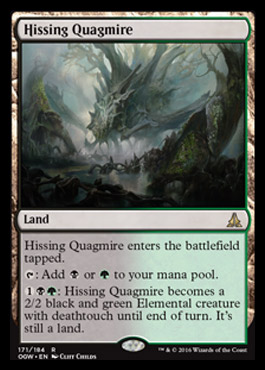
DJ Johnson – WHOOOOOO! I mean, I guess it’s probably fine in Standard Abzan and stuff like that, but I’m just glad because Life from the Loam is one of my three favorite Magic cards in existence, and I want to block big durdly things in Commander all day long. $5-6 at release, then $3-4 in the weeks following. Think Shambling Vent for a corollary here, not Lumbering Falls. I don’t think this one sees play in Modern though; Twilight Mire and Raging Ravine work together too well to give up any slots in the deck, except maybe as a one-of.
Jason Alt – This is the second man-land that seems better on defense than offense (the first was Stirring Wildwood) and I don’t know if that bodes well or poorly. This is an uncounterable way to murder a siege rhino or make it stay home, and having a man-and whose power and toughness are mostly irrelevant is odd. The man-lands in the last set did OK and this one has a better chance of being worth more being in a smaller set with durdlier cards. Still, what the man-lands didn’t do last time was ever exceed their presale price. Buy accordingly.
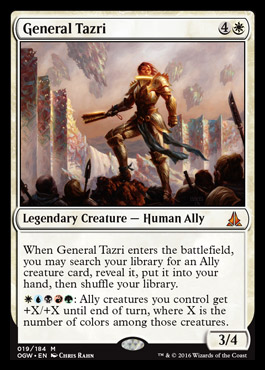
DJ Johnson: I really like the design of this card. They managed to make a 5 color general for Allies, while not butchering the casting cost of the creature. Foils of this are almost certainly going to be worth a pretty penny even after the initial hype of the set dies down, although non-foils are pre-selling at $20 a playset on eBay. I think that they’ll dip into the $3 range after the first few weeks, but this is a Commander foil that won’t be skimped over by the competitive crowd. Anyone who knows what Commander is will know that this is not a foil that will let be let go of easily.
Finance aside, it really frustrates me that we get another five mana Ally in this block. There were six total in Battle for Zendikar, and three of those were rare already. What’s the point of making a tribe where the goal is to play a lot of creatures onto the board that benefit each other, when they all cost a billion mana? I don’t even play Allies or have any desire to build the deck, but I feel so bad for anyone that was actually hyped about putting them together in Standard, or integrating new tech into the Modern version. We have one Ally in the entire block that costs 1 mana so far, and three in three different colors that cost 2 mana. Have fun with that.
Jason Alt – This card made James Chillcott go deep on Ally Encampment. That’s probably the right idea. The entire series I write about EDH is predicated on the notion that new printings have a better chance of pushing older cards up. Ally Encampment isn’t old, but it has equilibrated based on older information and now that circumstances have changed, demand is sure to be higher. Look at Sliver Hive for a few clues into Ally Encampment’s future. As for this card, it’s the Legendary Ally creature that EDH needed. This is white but if you know EDH, you know that the colors in the activated ability count towards its color identity meaning this can be your general in a 5-color Ally deck. This will be a good, valuable foil but I don’t expect the non-foil version to do much. Read my article from this week. This card is Nekusar, not Forced Fruition. This will drive prices up and it is a surprise we got another mythic in white but only EDH and casual care about this expensive, durdly card.

DJ Johnson – Did you need to clone something on your side of the board? How about waiting until you have seven mana, going into combat, hoping the top card of your library is a creature that’s actually going to benefit the rest of your creatures that you’ve somehow managed to play while also ramping to seven mana, then getting blown out by realizing your opponent killed you three turns ago? In all seriousness, this card is a bulk rare. It’s a really weird bulk rare that wants you to make a bunch of Scions, not use them to ramp into a seven mana Eldrazi, then hope the top card of your library is another big Eldrazi that you could have been ramping into. Zero applicability in Standard or Modern, and there are better colorless monsters to run in Commander.
Jason Alt – This probably isn’t playable in Standard, but you probably knew that. What you may not have known is that this probably isn’t as good in EDH as you may have thought. Creatures in EDH really need to have good abilities that trigger on your turn like Consecrated Sphinx or Seedborn Muse or abilities that trigger when they come into play like Avenger of Zendikar or Stoneforge Mystic. One use I do see for this is in a deck with a lot of tokens. While it’s true that power and toughness aren’t as relveant in EDH which isn’t necessarily a format where you swing at people, in a deck with creatures with Battalion, for example, this is nuts. All of the tokens you get from Assemble the Legion are now copies of Firemane Avenger. That seems good. I don’t know if it pulls it out of bulk rare range, but it at least seems fun, albeit random and chaotic.
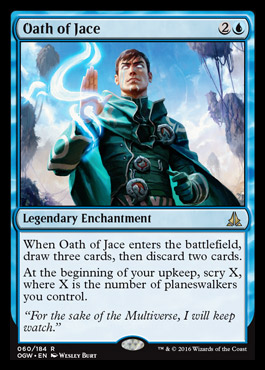
DJ Johnson: Cycle, anyone? We can expect a similar Oath from Chandra, Nissa, and Gideon, but where does that leave black? Are we going to get an Oath of Ob Nixilis where he’s saying “I do solemnly swear to destroy Zendikar once and for all”? I dunno, I’m not a lore guy. I do know that this is a bulk rare, because turning Compulsive Research into a permanent that lets you scry when you’re winning means one thing. It means my friend Jon who plays the planeswalker deck in Commander wants exactly one copy, nothing more. The same will be true for every Jon in your group. The design is interesting, but that doesn’t make it valuable. Although I do hope this becomes a Standard deck with Starfield of Nyx….
EDIT: After reading some feedback, I accept this could definitely see play in Standard considering it helps flip Jace almost instantly, and Gideon can add to the support. Playsets are $10 on eBay right now, which seems safe if you plan on playing with them immediately after the set release and already have a plan for a deck. Instead of pure bulk rare status, I think it’s safe at $1-2 depending on the nest it might find in a UW shell.
Jason Alt – Even if some Jace/Gideon deck emerges, I don’t know if a card that is a sorcery-speed Brainstorm that lets you scry, let’s face it, 1 every turn is going to be more than the $3 or so it is right now. It’s tough for a non-mythic to break the $1 mark these days. This rewards you for doing something you already like doing in blue decks which is playing Jace, but this card isn’t great without Jace. I’m really torn. Someone help me see a scenario where you’re glad you paid $3 for this presale.
12/30/15
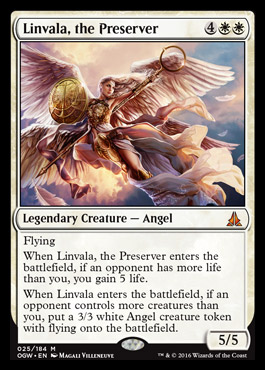
Linvala, the Preserver
Jason Alt – When it looked like all of the mythics were spoiled for the set and some colors had two mythics, white had 0 and there were 9 instead of the 10 we’d anticipiated, people speculated there would be a white mythic and it would be bonkers since it was kept under wraps. Well, now we know. It’s very, very far from bonkers. This is incredibly disappointing. This won’t even get put in Roon or Brago EDH decks, it’s way too slow to be a Timely Reinforcements in Standard and Modern and Legacy only cheat Angels into play if their name is Iona. This card is worse than a lot of angels that are just rare. I don’t know what happened to Linvala since the Eldrazi last rose, but she got real bad and durdly in the interim.
DJ Johnson – Well this is a disappointment for anyone who was hoping a decent return of Linvala. I knew that we wouldn’t get a reprint of the legendary creature from Rise of the Eldrazi, but I would have preferred something that was at least a little bit Constructed playable. Timely Reinforcements is extremely powerful, but that’s because it costs half as much as Linvala, while gaining the same amount of powers’ worth of tokens and even more life. Being Snapcasterable helps too. It might be worth playing in Standard if the power level post-rotation is low enough, but forget anything past that.
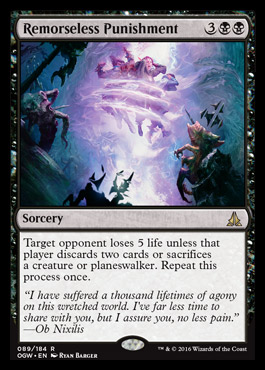
Remorseless Punishment
Jason Alt – This is most often going to read “Target opponent discards 2 cards and loses 5 life” which makes this a mega Blightning. I see people excited about this card and I want to stress that this suffers from the Browbeat effect that Bill Stark wrote about a decade ago when it was reprinted in Time Spiral. This will never do what you want it to do, but what your opponent wants it to do. If your opponent is under 5 life this can wreck them, or if their hand is almost empty or if they don’t have any creatures, it narrows their choices. We call cards like that “win more” because you’re going to break their back if you’re already winning, but if they are taking you to Siege Rhino town, you’re going to wish this was a Crux of Fate. I’m inclined to say this will presell for more than it should.
DJ Johnson – This card actually gave me an idea for an article, so I’m going to save most of the words that I want to say about it until then, to save you from reading an entire page’s worth of content when I’m supposed to tell you what the card will do financially. “punisher” cards like the Tribute mechanic and Browbeat generally don’t do what *you* want them to do, but I’ve noticed that most casual players really don’t care. There’s a reason Browbeat is still worth $1.50 and Dash Hopes is a $1 common. I’d be very surprised if this hit bulk prices, and if I can get these for $.10/$.25 then I’ll buy them aggressively with plans to resell for $1 later on. This is not a constructed playable Magic card, but that doesn’t matter. More on this next week.
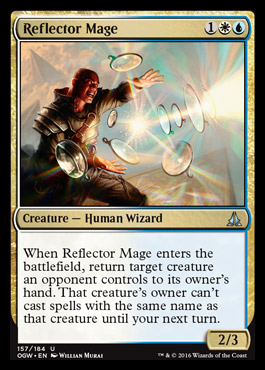
Reflector Mage
Jason Alt- This is worth mentioning because this card is nutter butters and you should snag foils. Foreign foils would be better. This keeps people off of their Commander, and if you play Roon or Brago, it does it every other turn. Cheating this into play at Instant speed or flashing it out and back in can keep them off of their Commander or another creature indefinitely. This is stupid in Limited, it’s stupid in EDH and the foils are going to be highly coveted.
DJ Johnson – This card is every Delver/Geist players’ wet dream from 2013. Easily worth $1 throughout its Standard career if it finds the right tempo deck. I didn’t even think about the Commander applications, but Jason’s right in that foils will probably hold a longer value than one would normally expect from a Standard-playable uncommon. Don’t let these be draft chaff, you’ll regret it later when grinders are hunting down playsets.

“Vile Redeemer”
Devoid
Flash
When you cast Vile Redeemer you may pay ◊. If you do, put a 1/1 colorless Eldrazi Scion creature token onto the battlefield for each nontoken creature that died under your control this turn. They have ” Sacrifice this creature: Add ◊ to your mana pool.”
Jason Alt – This is either a worse Nest Invader or a clunkier Fresh Meat with feet. This is certainly a little wrath insurance if you keep mana up against a deck with Wraths. I’m not sure this is good enough to be better than bulk as effects like this, while not always attached to a creature, haven’t gotten there traditionally and this is going to be harder to acivate than you might think.
DJ Johnson – I’m a fan of Fresh Meat and Caller of the Claw, which is a card that I didn’t know got reprinted until this very second. Huh. Anyway, this card is sweet. I don’t think its’ “Standard-playable sweet”, but it’s “bulk rare or $1 rare that I will sell tons of to casual Commander players sweet”. I like Fresh Meat better because it works better with tokens and more easily insta-kills your opponents post-wrath, but I still think this effect is attractive enough to non-competitive players that you should have these in stock to trade them out at a dollar. Don’t buy into the presale price, whatever it is.
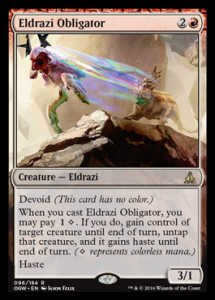
Jason Alt – This seems really good. As a curve-topper (you want this on 5) in an aggressive deck, you can probably deal the last 6 points of damage you need with this guy. Some midrange decks don’t start playing blockers until turn 4 and if you curve out, burn one blocker and steal another, there’s not much they can do. Stealing a big Eldrazi or something later means this isn’t a dead late topdeck. All in all, this could be punishing against midrangey decks. This could be a few bucks if Standard shakes out that way. That said, there aren’t a whole lot of BFZ rares that are over $1, so I won’t hold my breath. This likely presells for too much.
DJ Johnson – I don’t play Standard, but this seems like it has the stats to get there as the top end of an aggressive deck or to win the attrition war between two midrange strategies. That being said, I don’t think there’s enough power in the card to merit being worth more than a dollar long term. I’d draw a parallel to Mantis Rider or Radiant Flames; power level in rares doesn’t necessarily equal a “buy now!!!” strategy. Just let it be $1, and sell/trade them away at that into more tasty long-term strategies. Cards like……
12/29/15

Jason Alt – Long-term I think this card could get there, potentially. I think this will be overvalued at first due to how much hype I am seeing, then bottom out at peak supply. That seems like a good time to grab these, and if the foils aren’t ridiculous, grab the foils while the non-foil is at its low point. I don’t think this has the juice to influence Standard so it’s most like a long-term casual pick and that gives you lots of time to fill a box. If this presells for $5ish and up, stay well away IMO.
DJ Johnson – This is going to be overvalued during the first few weeks of the set. Ebay playsets are going for $8 right now, but there aren’t enough casual durdles with 60-card Superfriends decks to sustain that long term. I think this cuts in half to $1 over the next couple weeks, and you should absolutely pick these up when they hit bulk rare status. Mirroring what Jason said about the foils, because there are a lot more Commander decks built around Planeswalkers than you might expect. Don’t be in a hurry to pick these up though; you have a ton of time before they start creeping up in value.

Jason Alt – This is money. You should be able to find a few loose copies for easy trade or sitting around in chaff. This is removal so solid and so easy to include in a lot of Tier 1 decks that this will be worth more money than probably half to two thirds of the rares in this durdly set. Grab these if you can.
DJ Johnson – One of the more valuable uncommons in the set for sure. Just like Battle for Zendikar, it looks like the commons and uncommons are where the power level is at instead of rares/mythics. The promo of this is beautiful, and I’m sad that it won’t be in foil. That being said, I would always trade/sell these out at $1 and the promos at whatever they’re at when you get the chance. It’s hard to find someone looking to pay a premium to make their Standard deck look pretty,and there will be a huge influx of these all at once on Game Day. Don’t get stuck holding it post-rotation. Think of it like Strangleroot Geist; Sure, that promo is technically worth a dollar or two, but who wants it? Nobody, that’s who.
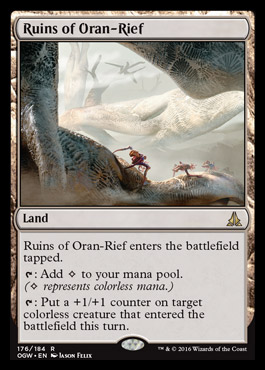
DJ Johnson – The flavor and design of this card are fun, especially since it plays so well with older artifact creatures in Commander. Triskelion, Arcbounds, and friends love stuff like this. Unfortunately, the fact that it only puts a counter on one creature instead of “each” really puts a damper on the power level. I was excited to make Myr Battlesphere bring in 13 power instead of 8, but that’s not going to happen. This is a bulk rare, but at least it helps newer players buld Colorless commanders with a slightly higher power level without having to rely almost entirely on Wastes basics, and without spending $800 on a manabase.
Jason Alt – It’s an Oran-Rief the Vastwood that can go in any deck. As far as ways to add colorless mana to your mana pool go, you could do a lot worse than this. However, why settle for just “you could do worse” when your deck space is limited. I want this in 40-card decks, I doubt I want this in 75-card decks and I might want this in a non-zero number of 100-card decks. I already run the original, non-ruined Oran-Rief in some green decks and if I want to be activating my Endbringer, this might get a look. That said, that won’t save it from the bulk bin.

DJ Johnson – This. THIS. I may be a Debbie Downer about 90% of the rares in this set concerning their bulk status, but this is the kind of card you can make easy money off of. The power level is there if we can find a way to cast a one drop creature in Standard, so you should be setting these aside from the packs you open, and not letting them accumulate with your bulk. I’m not saying its’ a guaranteed buylistable card, but someone at FNM will need a set of these in a few months, and you can get an easy $2-3 in trade for doing basically nothing.
Jason Alt- If Immolating Glare isn’t the most expensive uncommon in the set, this will be. Grab as many of both as you can.
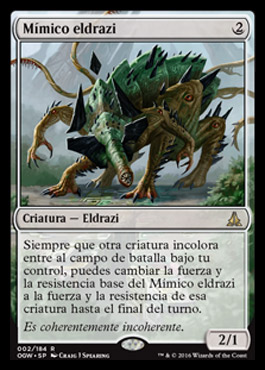
| Eldrazi Mimic – Creature – Eldrazi |
| Whenever another colorless creature enters the battlfield under your control, you may have the base power and toughness of Eldrazi Mimic become that creature’s power and toughness until end of turn. |
DJ Johnson – This reminds me a lot of Renegade Doppelganger from the original Eldrazi block. That saw a little bit of play, but it was only because Vengevine is disgusting. Eldrazi Mimic is going to take a lot more effort to get cooking; it only copies base power/toughness and not abilities, so we can’t pull any tricks with processing or other pump spells. The most you can hope for is copying Ulamog or Kozilek’s base stats in Standard, but why are you spending two mana on this for that kind of overkill instead of just ramping or drawing cards?
I am excited that you can cast it for free on turn 1 if you have Eye of Ugin, but you can only play 4 Eyes in a deck. I highly doubt the black/red Eldrazi deck that’s been cooking in Modern is going to need this, because that deck is relying more on early disruption and not playing Goblin Pikers for the hope that it one day becomes half of a Desolation Twin. I’m going to call this a bulk rare, but with hesitation. I would actually like to pick these up at a dime, just in case. I don’t think it will go anywhere, but at least it has slight potential unlike the seven mana 6/6 elves of the set.
Jason Alt – I feel like this card is a trick. In a vacuum I’m severely underwhelmed. They could print a card later that makes this look a lot better, but I don’t know how much I like this under any circumstances. This only copies power and toughness, only from colorless creatures and only off of creatures played after you play this guy, making it a garbage late-game topdeck. Blech.
12/28/15
It’s been about 10 days but we got a slew of spoiled cards today, so let’s get to it.
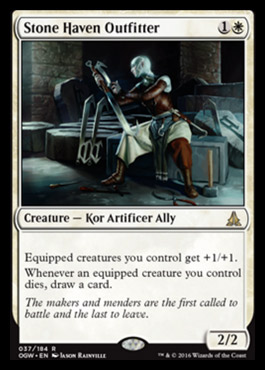
Stone Haven Outfitter
Jason Alt – As an EDH player, I am obviously hyped about a kor guy that deals with equipment, especially one that makes Skullclamp read “Draw 3 cards instead” when your Skullclamped creature dies. I don’t know that anyone is building Kor decks, even with Ayli, eternal pilgrim and Armament Master and all kind of other creatures running around. This is a weird card and based just on EDH play, I don’t see this getting above bulk.
The real question is whether Standard and Modern can do something with this card. Is this strong enough to make an equipment deck better than the Boggles deck? I really tend to doubt it. Equipment is clunky in Modern and with Stoneforge Mystic banned for the time being (although a lot of people are buying in heavily, banking on an unban – behavior we have seen before) it seems really even more unlikely.
Standard lacks good equipment for this card. Ghostfire Blade and Sword of the Animist are unlikely to be enough of an impetus to play this card in Standard and the bonus is too small to play clunky cards. This isn’t Puresteel Paladin and it shows. I think this is likely a bulk rare.
Douglas Johnson – This is much more awkward to combo with than Puresteel Paladin. It’s asking you to go wide and equip multiple creatures instead of just Voltron-ing everything onto one guy, so Skullclamp seems like the strongest way to abuse the trigger multiple times. Unfortunately, it actually makes Skullclamp itself harder to abuse, because your ‘clamped guys will end up getting +2/+0 instead of -1 toughness, so you can’t just pay 1 colorless for each time you want to draw 3; you’ll have to have a sacrifice outlet.
I’m calling it a bulk rare right now, so get ready to sell it to the local Kemba/Nahiri player as soon as you open it. SCG is selling it for a dollar right now, so that should give you some insight into the vendor confidence of the card as a presale.
R/Spikes post about this card.
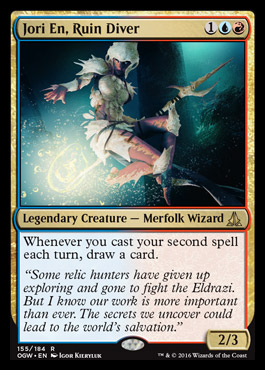
Jori En, Ruin Diver
Jason Alt – I don’t think you want this as your EDH General, personally. If anyone played Tiny Leaders, this might be good in that, but no one does. This puts you in somewhat good colors to be playing a ton of cantrips, but it’s not better than Talrand or Melek and doesn’t really enable much. I like this card but I don’t know where I like it.
Modern Merfolk might want to toy with this a bit, but it’s hard to see people splashing red to draw cards when they can easily jam Sygg, River Cutthroat instead without having to monkey with a manabase that has a bunch of mutavaults in it.
Standard is where this card shines least. With the current Standard card pool, there aren’t really enough enablers. Could we get some cheap cantrip artifacts? Maybe. Maybe a Chromatic Star or something that can help us in Limited when we greedily take all of the non-Basic land that produces colorless mana. Still, I don’t think I like this card much in Standard. This is a bulk rare if it doesn’t find a home, which is too bad because it rewards you well for playing a very specific game people are already playing. It’s just that other cards do it better.
DJ Johnson – Call me cynical, but I don’t see any reason to get excited over this card. There are better Commanders for Izzet spellslinging (Melek and Mizzix are way better at chaining off instants and sorceries for a fiery finish), so you have to ask yourself if this is worth playing in 60-card land. Wizards just doesn’t want to give us cheap cantrips anymore, because they learned that Spikey players can abuse the hell out of them with low cost, blue, aggressive creatures. It’s sad because this is design space that’s not frequently visited, but the card just doesn’t stand up to par in power level.
R/Spikes post about this card.

Tyrant of Valakut
Jason Alt – Every once in a while, a big, durdly red dragon will get printed that’s amazing in EDH. The Standard crowd will ignore it and it will go on to be worth a ton of money because of how busted in EDH it is. This isn’t that dragon. Bogardan Hellkite is always better.
A lack of surge enablers is going to cripple this card in Standard and in 2HG Limited, any dragon is good. This is great for that and basically only that and that’s fine. A lot of cards that might not have been bulk are likely getting made bulk by the Expeditions anyway, so quibbling about whether this is a $1 or $1.50 card doesn’t matter. This is a dime.
DJ Johnson – I’m really sick of stupid bulk rare dragons getting a spot in every single set. I know why they get printed, and I know that they continue to sell packs to non-competitive players, but it sucks for the rest of us who want to see interesting design space, unique abilities, and non-garbage rares. The surge rate isn’t actually all that horrible for Standard, but we’re not going to have stuff like Gitaxian Probe or Preordain to precursor this in a two-player game. It’s unplayable if you’re not Surging into play, so I’m not going to spend anymore words talking about my grievances with a dime.
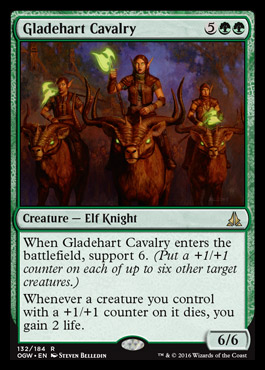
Gladeheart Cavalry
Jason Alt – Yuck. a 7 drop, 6/6 elf? What a flavor fail. Sure, this bolsters (nope, can’t use that verb since it’s a dumb, useless keyword ability just like support) 6 creatures, which is great if you’re already winning. A 7-drop should be able to pull a game out of the toilet and this doesn’t do that. In a deck with a lot of mana dorks, this could come out early and makes those dorks into real beaters and you could gain 14 life if they wrath, but your life total doesn’t matter against control. This card is just so clunky. This is likely a bulk rare.
DJ Johnson – Do you need to gain 12 life as a consolation prize after your opponent Wraths seven of your creatures away on turn 9? Do you want to feel the nostalgia of casting Vizzerdrix in a green deck? Do you really hate Magic and want an excuse to go back to Card Fight Vanguard? Say no more! I’d like to offer you an incredible deal on the new “Gladehart Cavalry” Magic: The Gathering MTG card. For a mere $.10 + shipping/handling, this card can be YOURSSSS!!!!
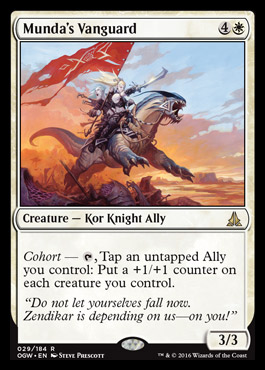
Munda’s Vanguard
Jason Alt – Allies are a deck that people are going to try to build in Standard, I’m sure. The problem isn’t enough support of allies in the form of creatures that support your other allies or lands that make it easy to play a 5-color deck. The problem is a lack of support from the rest of the set. RWG allies in the last Zendikar Standard was a deck not because of the allies in it but because Bloodbraid Elf did so much work in the deck. I worry that jamming the deck full of 5-drop durdles will make it unplayable. We didn’t see a good Slivers deck, either, and that had more support over the 2 core sets than allies is getting in the current Standard. This is a 5 drop 3/3 most of the time. If you use this ability on their EOT it means you didn’t attack with it. 5 mana for a creature you don’t attack with seems lame, although the other ally you tap can be summoning sick so that makes the cohort ability a little more palatable. Still, this is just slow and clunky and I don’t see this clawing its way out of bulk rare range.
DJ Johnson – It must be “Bulk Rare Monday” at Wizards or something. They sure know how to put a carrot in front of us to get us hyped for the new set; since all of the Expeditions and most of the Mythics got leaked early, they’re biding their time and playing the suspense game, showing us all of the bulk rares first and playing up to the grand finale of the last amazing white Mythic that hasn’t been spoiled yet. It’s either that, or the rest of the set is a load of garbage. I sure hope its’ the former.
As for actually analyzing the card…. Isn’t this the 6th five mana rare Ally in the BFZ block? Seriously, how many do they expect us to play? We still only have a single one mana Ally in Standard, and it’s Elite Vanguard. Either way, I’m certainly hyped up to tap two of my creatures in a supposedly aggressive deck to give them one more power each. Synergy at its’ finest. Bulk rare synergy.
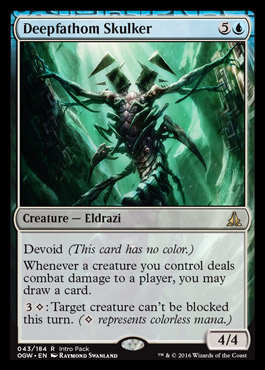
Deepfathom Skulker
Jason Alt – Bident of Thassa is back, but now it costs twice as much and dies to creature removal. The upside is it has a significant body on it. The downside is what deck with blue wants a 6-drop beater that requires you to manage the number of colors you play in the deck so you make sure you have enough pure colorless to activate this ability? This just seems like a card without a deck, and that’s never a good sign. Bident of Thassa got there because there were a slew of blue beaters ready to go in the deck once people saw Master of Waves for what it was. We’re no longer being rewarded for playing Mono Blue and Skulker likely has no home.
DJ Johnson – This card is pretty backbreaking in Limited, but you can pretty much say that about any creature that costs 6 and draws you more cards. Even Bident of Thassa was basically a bulk rare for its’ entire life in Standard, and it actually saw play in a Pro Tour deck during peak demand. I get that we’re supposed to be looking at this card from all angles and explaining how it *might* see play *somewhere*, but Wotc is making it really hard today by grinding the power level of this block into Eldrazi-looking dust. I don’t need to say the magic words, but I have to anyway. Bulk. Rare.
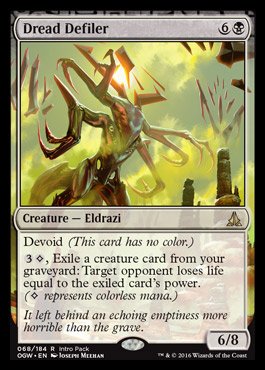
Dread Defiler
Jason Alt – This is a little bit harder to evaluate since its ability could do a lot more damage for 4 mana than Deepfathom Skulker’s. I imagine this could get there in EDH as an ability, but I’m not so sure I like it as a creature. A vanilla 6/8 for 7 is really not exciting in that format and utility creatures usually cost a little less so you can use them a bit. Late in the game, with a full ‘yard and plenty of mana to activate this multiple times and, more importantly, activate it the turn you play it, this could get there. However, as good as it is in some instances, this isn’t better than Smothering Abomination, currently a bulk rare. Standard won’t like this more than EDH does and EDH will never push this above bulk.
DJ Johnson – The ability on this card can certainly do a lot of damage, but it requires your opponent to be playing a specific deck, and it requires you to be playing a specific format (Commander). This might get there as a 1-of in Standard in the green/black Eldrazi mirror match for after you kill their Ulamog, but I’m really reaching here. Realistically, you’re going to trade this to someone who’s trying to build an Eldrazi Commander deck for $.10. Actually, forget I just said that. Realistically, you’re going to have this sit in a bulk rare box for 3 years before you decide to bulk it out to a vendor at a Grand Prix.
12/18/15
Jason Alt – Again, just one, but it’s bugnutty for EDH and may be good enough for Standard.
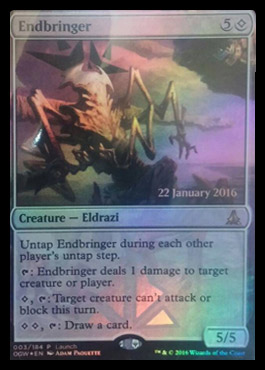
Endbringer
Jason Alt – This card is stupid good. To me, this is a better Staff of Nin. It’s got upside because there is a body attached but it’s not succeptible to all of the artifact removal in EDH. Dying to creature removal is a bother but it’s good that this can die somehow because it’s going to ruin lives. Stack the untap triggers with Prophet of Kruphix to pain a real target on your face or just grind out value for every player at the table. With Sol Ring and Pain Lands and Temple of the False God, you should be able to generate enough true colorless mana (what else do we call diamond mana?) to power this a decent amount of the time. This is practically a planeswalker in EDH and I’m excited to jam it.
In Standard, we do have a few Eldrazi ramp decks and this can grind a game out as well as any bigger Eldrazi can end it quickly. Card advantage, control elements and 2 damage a turn cycle is amazing. As an attacker it has pseudo-vigilance and its body is a good rate. Being non-mythic limits its financial upside unfortunately but if this hits bulk, I’m making a fat stack. I like this as a card that can improve the win rate of nearly any EDH deck that is struggling to draw cards and use in Standard could see its price move up, but I have to imagine this will be overpriced at a few bucks at preorder like every card in BFZ. No money to be made short term, but I’m socking these away and buying in bulk when they hit that rate, if they do.
DJ Johnson – I am going to love buying these for a dime each. This fits into practically any Commander deck that can jam Sol Ring/Temple of the False God. It’s definitely going to be a bulk rare, so don’t go buying infinite copies at $.50. I’ll buy them at $.10 and sell them for $.20, then the person who bought it is going to wipe the face of their playgroup, then I’m going to sell three more copies to help the arms race grow.
I really wish this was an artifact, so I could abuse Unwinding Clock and Clock of Omens with it in Glissa. Other than the wall of text that Jason provided, there’s not much I can say.
12/17/15
Jason Alt – Just one today and it’s pretty weird.
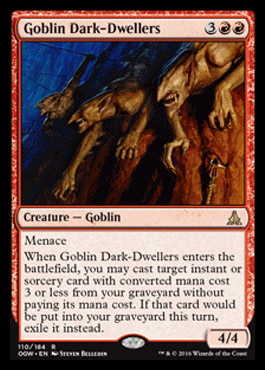
Goblin Dark-Dwellers
Jason Alt- Snapcaster Mage is good, but why? Is it because he draws us a card and that card is the best card in our graveyard? Is it because he’s a 2-drop? Is it because he has flash? His tribal affiliation? The art? This card is very little of what Snapcaster Mage is. We have had attempts at Snapcater before, namely Dualcaster Mage which never really got there and Abbot of Keral Keep which really did. Which is this? Do we even want this? EDH players are likely going to stick to Mindclaw Shaman or Dualcaster Mage or not playing mono-Red because those choices both kind of suck. This could see play in Standard, however. If you’re using this to play a 3-mana spell, the 5 mana becomes the same as paying 2 mana to snap back a 3 mana spell and you get a 4/4 instead of a 2/1. Snapcaster gave you the element of surprise and snapped back Counterspells. This doesn’t do that, but what it does do is give you some inevitability. A second Crackling Doom could be back-breaking. Another Exquisite Firecraft, perhaps. Spikey players are very excited about this card and that is worth knowing about. I have no idea where this will begin to presell, but I see this going for around $12-$15 based on the hype and I think that’s too much. I imagine this won’t sneak in under the radar and go up when people discover its power, but rather the opposite, I fear.
DJ Johnson – This seems really good in Standard, not good in EDH. SCG sold out at $1.99 on 12/19/15, so some people who are smarter than I am must like something about this card. You can find playsets on eBay for $15, and I still think that’s a fine “just in case” pickup price if you think you’ll play these in Standard during the first couple weeks of Standard. I wouldn’t buy in at $4-5 for speculation, so stay away if you’re not a grinder.
12/13/15
Jason Alt – We got quite a few spoilers today, and it started relatively innocently with a solitary spoiler, leaked on purpose by Wizards a day or so ago.
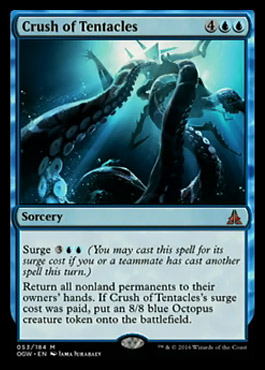
Crush of Tentacles
Jason Alt – This is much better for spoiling the Surge mechanic and ruining games of 2 Headed Giant (straight ruining them. You want to lose on turn 6? You’re going to lose on turn 6, probably) than it’s going to be for Standard. Some control players wonder if this is the card that could be the go-to control finisher from now on. I’m not as bullish as most. I do like the idea of jamming a 1-mana cantrip then taking your opponents to tentacle town but I worry that they’ll just recast all of those Siege Rhinos with the lands you let them keep. In EDH this is flavorful and also just a sort of disappointing, slow Cyclonic Rift that can’t save your bacon early. In Standard, Cyclonic Rift was better in multiples than this. I realize we should evaluate this on its own merits. I may not be the guy to discuss hardcore Standard theorycrafting. Here’s what reddit spikes think.
DJ Johnson – One of the upsides of the Surge mechanic is that it gives my fiancee’ and I something to do on Valentines’ Day instead of staying at home and doing nothing all day. Not that that’s a bad thing, but I think she’ll enjoy the pre-release more if we get to sit next to each other for the entire event, and actually play together. As for the card, buuuuuulk mythic. I’ll parrot Jason and say that its’ going to be a poor man’s Cyclonic Rift, which is already a pretty powerful budget card. I don’t want this in EDH, and the only guy that does is probably playing Whelming Wave tribal. Make that guy’s day by selling this card to him for like $1-2, and then move on with your life.
Nissa, Voice of Zendikar
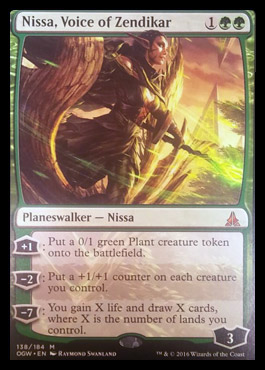
Nissa, Voice of Zendikar
Say, what happened last time we got an iffy planeswalker in an iffy set?

Jason Alt – Oh, right. Even the dearth of exciting cards in Dragons of Tarkir couldn’t save Narset. Do you think Nissa is better than Narset? How many dollars better? Also, expeditions will ensure this set sells better than that one. So the real factor here is whether we will see other mythics in the set that could soak up some of the value that Narset could not. Also, we could get a ton of elves or allies or creatures you want to build around this walker. I don’t think it’s powerful enough in a vacuum and will really need to pal around with some creatures to make any of its abilities worth using. That said, being able to draw like 6 cards and gain 6 life on turn 6 could make this a must-kill Planeswalker. Should we evaluate ‘walkers in terms of their ultimate? Well, no. But Nissa isn’t giving us much else to work with.
DJ Johnson – I guess being the “voice” of Zendikar means that she’ll just yell at you and pretend to be threatening by making 0/1s. Gideon is the “Ally” of Zendikar, so he’s actually gonna get up and beat some colorless clowns to the ground. Nissa will pretend to do things that are relevant. Planeswalkers at pre-order prices are historically bad, and I’m going to repeat that for new Nissa. At least with her Origins form you got a body that could fight, and an ETB effect to abuse.
Chandra, Flamecaller

Chandra, Flamecaller
Jason Alt – Yuck. I like how aggro this card is. 6 damage worth of elemental tokens the turn you summon her means she is here to kick ass and chew bubblegum and ran out of bubblegum. But like some bubblegum chewers, she can’t chew gum and do something else at the same time, namely defend herself. Like, at all. And red isn’t really the color of defending your planeswalkers, either. Sure, she brings herself to 5 loyalty right away, which is formidable and her other abilities are pretty sweet. Worst case scenario, you can Firespout the turn you play her and hope nothing lives to finish her off. But 6 mana is so many mana. So which 6 mana planeswalker is she most like?

Is Chandra like this 6-drop?

Or this one? Chandra Ablaze made next to no impact on Standard and had to rely on inclusion in a weird Modern deck and the casual appeal of the card to drive its price up past its prime. I see new Chandra as more like Chandra Ablaze and I’m worried it may have to soak up more value than demand can sustain. I think it’s almost certain to be a $30+ preorder and I’m staying away at that price.
As an alternate point of view, Patrick Chapin likes this card and he had been historically pretty good at identifying good planeswalkers. What really needs to be seen is whether this goes in more than just one deck.
DJ Johnson- Stop telling me that this card is like Ball Lightning. Ball Lightning had trample, costed half as much, and killed people quickly. People are going to preorder this at something dumb like $25, and then tell you that its’ the next Sun’s Champion. Just smile and nod, and offer to sell them your copies at whatever they’re at when you crack them at the prerelease. There are so many damn Chandras now, I don’t think this one fights its’ way to the top. Six mana is so much mana….
World Breaker
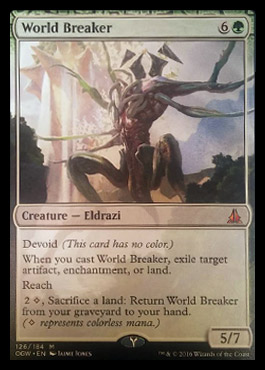
World Breaker
Jason Alt – This name is way cooler than the card and it’s a pretty cool card. Standard ramp decks can easily cast this on turn 4 or 5 but to what end? Blowing up a land of theirs could set them back a turn but there are way juicier targets for its ability in EDH. This is an obvious EDH card but Standard is going to determine what its price does initially and I’m not sure this is good enough. A Giant-er Spider that blows up a land or maybe some equipment – what say you? Could its recursio be the factor that gets people to play it in Standard where it will shrug off wraths? I need to see a price before I say whether its price is wrong, but this feels vaguely familiar to me.

Oh, right. That’s where I remember it from. From being just like a card that underwhelmed everyone. Is World Breaker a better and more useful card? Yep. Will it be worth enough money that I will be glad I bought at $5 rather than glad I sold at $5? I don’t think so, personally.
DJ Johnson- Jason beat me to the punch on all of these unofficial spoilers, but that doesn’t mean I can’t second his motions and agree with everything he’s said so far, while adding my own unique and witty banter to the commentary. If this sees play in Standard, I think it’s as a 2-of in the sideboard of the Eldrazi Ramp deck, as a problem solver for control decks that you can recur repeatedly. That does not justify a $5 preorder price, so ship them when you pull them, and sell them as bulk mythics later on.
Kozilek’s Return
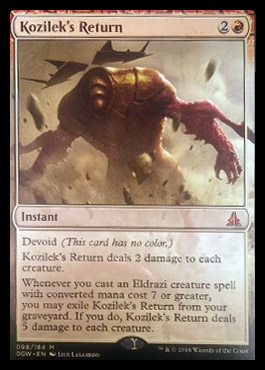
Kozilek’s Return
I like this spell quite a bit. While it would like be too good if it dealt 3 damage, the 2 damage feels a little weak. Not to worry, playing this in a Green-Red Eldrazi Ramp deck will clear the board of Rhinos and Griffins and other nasties that you can’t get with Languish. Nail their dorks early and get their second wave later with a well timed Eldrazi? Don’t mind if I do. What this card gains in having more range than Languish it more than makes up for in being super narrow compared to languish. Languish can only go in black decks, sure, but at least that black deck doesn’t have to play 7 mana spells if it doesn’t want to. I fear how narrow this card is will overshadow how good it is. Good cards with no decks to play them in are more familiarly known as bad cards. I hope this sticks because it’s fun and powerful, but I don’t know if it can reasonably break the $5 mark long-term unless Eldrazi decks start to get there.
DJ Johnson – You can play this in one deck. Maybe two decks, if you count two different formats. Even then, I think there are better early game board wipes in Modern, so I don’t expect this to replace the original Pyroclasm or Firespout that
Sphinx of the Final Word

Sphinx of the Final Word
“Crackling Doom? Are you serious? Yeah, it’s dead. Crap.”
“I’ll block one of your goblins with Sphinx of the Final Word and the other 7 hit me for…lethal. Crap.”
“Your Dragonlord Ojutai may have hit me twice already, but now I have something that will trade with it! Oh, wrath? Crap.”
These are a few things I expect people who try to play this in Standard to say. I think it’s pretty good. I also think it doesn’t do what you need control finishers to do. Dragonlord Ojutai is the go-to card in that slot and it also has Hexproof, is 2 mana cheaper and draws cards. This is good at saying no, but it also says that when you ask it if it feels comfortable carrying your control deck over the finish line. This feels like a mythic, but not in a good way. This is mythic like Godsire is Mythic. This is mythic like Nercopolis Regent is mythic. I realize that comparison breaks down a bit because casual players played with those cards eventually. Could EDH use this some day? Mehbe, but emphasis on meh.
DJ Johnson- I’m so glad that they printed another seven mana sphinx that does basically nothing. I was getting worried that the first 36 Sphinx’s weren’t enough to convince us of the fact that this guy surely has a spot in competitive play. Other than Consecrated Sphinx, which is arguably ban worthy in Commander, no other sphinx has ever made an impact on anything in constructed, ever. This is a one dollar Magic card, if that.
Kalitas, Traitor of Ghet
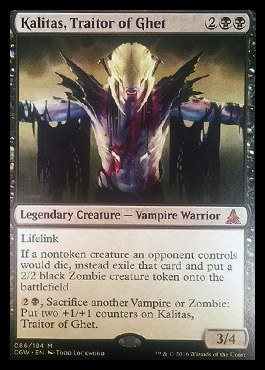
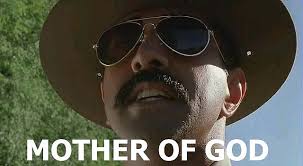
Kalitas, Traitor of Ghet
Jason Alt – This card is pretty strong. It can even feed itself the tokens it creates to get huge and get out of burn range. This is going to stiff-arm red decks pretty convincingly, gaining you life to put you out of burn range and buffing itself so it can’t be burned out. This card is very exciting and I imagine it’s going to have to soak up a lot of value in the set.

I expect Kalitas to be $25 at some point. Will he do as poor a job of maintaining it as the last card I was excited about? Maybe. Also, this card got the song “Hotel California” stuck in my head, so thanks for that. Traitor.
DJ Johnson – Now this is a card with some legs. We have three very relevant abilities, but now we need a deck for it. It single-handedly shuts down mono red and other hyper-aggressive strategies, but it has to actually fit into some shell. Is it the bombshell $25 mythic of the set? I have no idea, I don’t play Standard. I’d still advocate selling these at pre-release though, playing it safe is always my preferred strategy.
Blighted Crossroads(?)
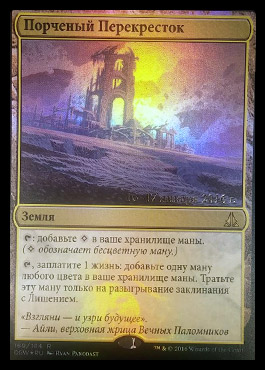
T: Add ◊ to your mana pool. (◊ represents colorless mana.)
T, Pay 1 life: Add one mana of any color to your mana pool. Spend this mana only to cast spells with devoid.
Jason Alt – Anyone excited about a worse, narrow Mana Confluence? At least this taps for colorless so you can cast Kozilek. Why didn’t they just reprint Mana Confluence?

@#$%!
DJ Johnson – Stop trying to make mono-devoid a thing. It’s not going to be a thing. I personally wish the wording on this said: “Add one mana of any color to your mana pool. Spend this mana only to cast colorless spells, or activate abilities of colorless permanents.” Then it would be useful for activating abilities of lands, artifacts, and other crazy stuff. It would be useful in general, really. Not like it is now. Buuuuulk rare.
Spire’s Needle(?)
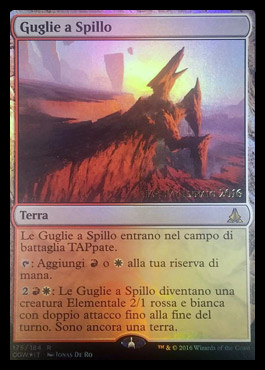
Spire’s Needle enters the battlefield tapped.
T: Add R or W to your mana pool.
2RW: Spire’s Needle becomes a 2/1 Elemental creature with double strike until end of turn. It’s still a land.
Jason Alt – Now this, I can get down with. The 1 toughness sucks and by turn 5, they’re likely to have a 3 toughness dude this will end up trading with, but any buffs to this and it’s insane. What’s that? You can target manlands with Awaken to put counters on them? Well, that’s dandy. That’s all kinds of dandy. Shambling Vent is $5 and I think probably a better card. Buy accordingly.
DJ Johnson – This is pretty sweet design (and by that, I just mean I’m glad they didn’t wuss out and make it a 4/1 with first strike or something), and I definitely want one in my Child of Alara deck because its’ silly with Kessig Wolf Run. That being said, I don’t think its’ as strong as Shambling Vents. I think it stays at $2-3 as the first weeks of the set go by, and I would definitely move the copies you get at the pre-release. I am glad that this gives RW decks a way to come back from Wraths though.
Holdout Settlement
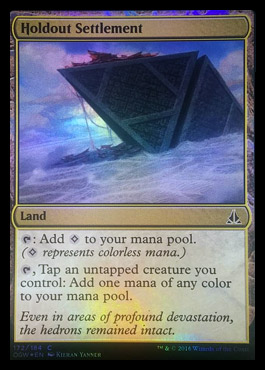
Holdout Settlement
I remember making a bet with a guy on Reddit that Pain Seer would never hit $10 after it came down from its initial presale price (one guy in the QS forums said he was going to sell his Dark Confidants because Pain Seer was just better and that kind of “Post before you read the card a second time” hysteria may be why Pain Seer sold out at $12 on SCG) and if it did, I’d eat a playset of foils. I never ate that playset of foils. Could this land have made Pain Seer hit $10? No. But it’s making me want a foil copy for my King Macar the Gold-Cursed EDH deck which is a real, actual deck I have and if Koskun Falls becomes the second card worth having in Homelands, it’s Holdout Settlement’s fault for making Inspired cards next-level.
Unknown Shores

Unknown Shores
They sure are printing the same land a lot of times.
Crumbling Vestige
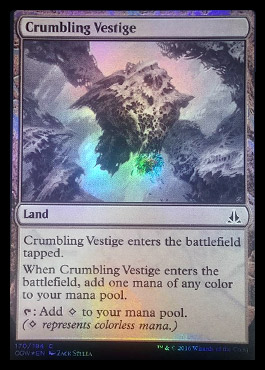
Crumbling Vestige
This is the best subtle twist on the same card they keep reprinting over and over. There sure are a lot of lands that tap for colorless mana in this set. I bet we get a lot more “diamonds” in casting costs, right? Why else all the doofy lands at common? This set almost gives us enough to build the mana base for a Karn EDH deck without Wastes.
Sea Gate Ruins(?)
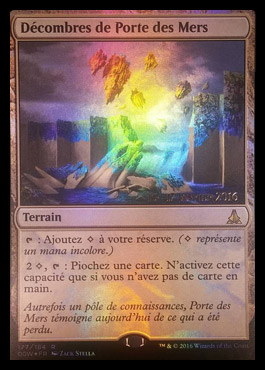
Land
T: Add ◊ to your mana pool. (◊ represents colorless mana.)
2◊, T: Draw a card. Activate this ability only if you have no cards in hand.
Jason Alt – Oh, good god. This card is amazing. And it’s non-mythic? Imagine what this would go for at mythic. This may be the card I’m most excited about in this set and I wrote a love haiku to Mirrorpool and serenaded it outside its window. This card even looks sexy in foil. While this is powerful it’s also a little bit awkward. Is this the next Library of Alexandria (Lol, no)? Is it the next Mikokoro? Maybe. Is it the next Blood Scrivener? Also maybe. Outside of Standard, this suffers from the same “awkward to activate” problem as Mirrorpool but EDH players playing Hellbent can find a way. Burn decks need this card. Luckily it’s non-Legendary, so go to town.
DJ Johnson – The fact that this is non-legendary means that playing it as a 4-of is fine, especially since you can use one to pay the colorless cost for the other The Atarka Red decks of today are pretty strict on the RG mana though, so I’m not sure if this fits in burn just yet on release. The ability is very powerful in EDH though, and you don’t have to sacrifice it like most other ability-lands nowadays. Even though Jason is drooling above me, I’d rather play it safe and sell these on release. Hold off for now, I don’t think it’s a $5 rare. You can probably pick these up for a dollar or two around Game Day.
Tranquil Immensity(?)
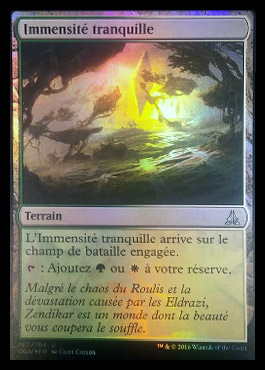
Jason Alt – “Blossoming Sands is OP. Nerf it by taking away the life gain and make it uncommon so it doesn’t ruin the Limited format” – Someone at WotC, I guess.
DJ Johnson – “You know what players will want? They want to open up a basic land in the basic land slot, and THEN they want to open up a Wastes at common, and a Tranquil Immensity at uncommon. Players love lands, right?” – Someone who should hopefully be fired.
Initial Spoilers
The first few cards spoiled came so early their authenticity was questioned but pretty quickly people latched on and subsequent spoiler releases all but confirmed them.
Kozilek, the Great Distortion
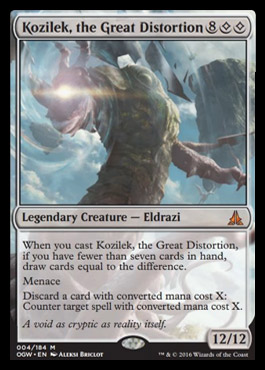
Kozilek, the Great Distortion
Jason Alt – This didn’t look real at first to most of us because we were concerned the weird diamond symbol was some weird kind of 6th mana. Now we know it’s colorless mana that has to originate from a colorless source and it’s different from generic mana that can be colored mana used as colorless. Pretty simple and elegant, frankly. We can get into the elegance when we discuss Wastes, aka Barry’s Land. What do we expect from Kozilek?

I think this won’t be too far off, frankly. Kozilek is a little worse imo but so is the set it’s in which means Standard players might regard the set as “Oath of the Dragon’s Maze of Tarkirwatch of Kamigawa.” If they do, the price of good mythics is going to be out of control, like we’re seeing with cards like Dragonlord Ojutai and a few other cards in an otherwise pretty lackluster set. Could the casual gold buoy the price of Newzilek (Newlamog rolls off the tongue better, I know) or will it be around $15 in a few months? I’m inclined to say either way, it’s going to be too expensive at preorder and you will want to stay away. Bust these and sell them if they’re around $20-$25 early. Kozilek is cool but he’s no Ulamog.
DJ Johnson – Meh. I’m not all too impressed, and I definitely like Ulamog better in Standard (but that’s not saying much). Menace seems really awkward to tack on instead of trample (you’re telling me two squirrels can jump in front of that thing to take the hit, and you walk away fine?) I agree with Jason that he’ll tank out of the gate until hitting $10 or so, then you’re free to pick him up from there if you need him for your crazy shenanigans wingdings mana deck.
Wastes
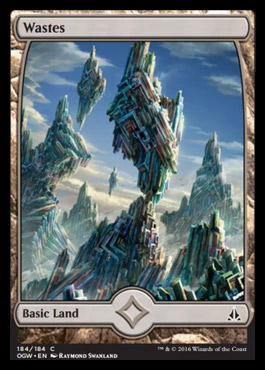
Wastes
Jason Alt – This is pretty cool. Also, foils are confirmed and it looks like this is in a common slot rather than a basic land slot. Do I see a potential corollary?

I actually see foil Snow-covered Island as a corollary for the minimum price, rather than the maximum. I may hear some dissent on this, but these are EDH-legal, standard-impacting, basic tutorable, full-art Barry’s Lands. I like the foils a lot and future printings of Wastes, if they happen, are very unlikely to be full-art. Snatch these foils.
DJ Johnson – While Jason goes crazy over the foil full arts, I’d like to remind everyone to keep the nonfoils as well. These aren’t draft chaff, these are Shadowborn Apostle-level commons where one guy at the shop needs like 40 for his deck, and it ends up being $1 retail and $.25 buylist. Don’t forget about the nonfoils.
Ayli, Eternal Pilgrim

Ayli, Eternal Pilgrim
Jason Alt – Be still my beating heart. A legendary black-white cleric Commander. This card has an aggressive power and toughness to casting cost ratio and deathtouch is solid and its ability to exile stuff makes it brutal on a stick, but I don’t know how good this will be in Standard. What I do know is that this is EDH gold and while that doesn’t do much for prices, this is likely to drive the demand up for a bunch of old, black and white clerics and that’s worth paying attention to. I’ll write about this in more depth soon.
DJ Johnsons- Meh. I’m not an Orzhov guy in Commander, but I do respect this guys’ power level. I’m pretty sure he’ll be a bulk rare, but foils will be relevant unless they get Intro Packed. Read Jason’s article about this.
Mina and Denn, Wildborn (?)
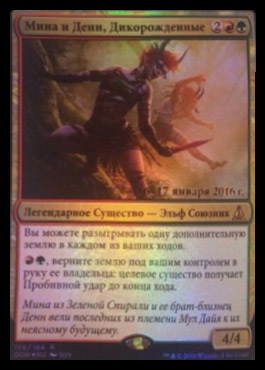
Mina and Denn, Wildborn
2RG
Legendary Creature – Elf Ally
You may play an additional land during each of your turns.
RG, Return a land you control to its owner’s hand: Target creature gains trample until end of turn.
4/4
Jason Alt – Well, this is certainly a card. I really like being able to play extra lands, and the rate certainly can’t be beaten. a 4/4 for 4 with upside is certainly very appealing. Being able to trample your way out of ground stalls and enable 2 landfall triggers a turn is nice upside, too. I think this is a fun build-around commander for EDH and will probably not be worth anything or drive the prices of many other cards up. So that’s a lame thing to have to say about a card I like, but that’s my job. I still like Smothering Abomination as much as I ever did but if you remember I called that a “don’t buy yet” and I feel similarly here.
DJ Johnson – I actually care about this more than most people, because (you guessed it) of Child of Alara! More Exploration effects are always welcome in that deck, although I’m not sure what I’ll be replacing just yet. Giving things trample in that deck isn’t super relevant because I already have Wolf Run and Child itself, but… oh, wait. Finance stuff. Right. Buuuuuuulk rare. Now, let’s talk more about why I need a foil copy for Child…..
Mirrorpool

Mirrorpool
Jason Alt – I don’t know whether this will impact Standard. That’s not for me to decide. What I will say is that if this ever craters, pay attention because this is the EDH-iest land ever printed. This does everything you want a land to do in that format and you can bring it back with Crucible of Worlds and do that thing again. Copying an Eldrazi seems busted if it’s non-Legendary and this taps for colorless which helps you play Kozilek. I don’t know whether this is good in Standard and I know this is going to be awkward to activate if you don’t have your trusty Sol Ring but I don’t care. This land is stupid. I love it.
DJ Johnson – The first time I read this, I skimmed over both of the “you control” clauses, so now I’m not nearly as excited about this card. It’s still pretty good in Commander, but not “auto include in every deck oh my god it’s the best thing ever”.
Expeditions
DJ Johnson – Well, I’m sure that we were all blown away by the reveal of this round of Expeditions. Instead of getting clean cycles of 5-5-10 like everyone expected, we got 10-1-1-1….. you get the idea. Wizards really wanted to push a lot of colorless mana sources into the expedition slot, partially to promote the new symbol to represent colorless mana instead of generic. Before jumping into the next 20 pretty lands that were shown before they were supposed to, let’s look at the current Expeditions as a baseline to compare to:
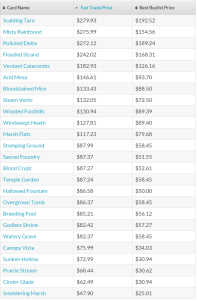
Without further rambling, let’s go over this seasons’ lottery tickets!

Filterlands:
DJ Johnson – Pretty much everyone expected these, so there’s not a huge surprise. While nothing in the set will top the almighty Wasteland, these will still be the ones that people complain slightly less about when they crack them during drafts and free booster packs that their SO got them for Valentine’s day. If the general rule of the higher end Expeditions is “Around $200”, then I think that’s where the higher end filters like Twilight Mire will end up.
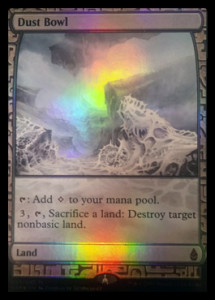
DJ Johnson – Man, I love this card. I’m seriously considering going all-in on Expeditions with my Child of Alara, although I know that if I do, I’ll be forced to actually play Magic a little bit more to showcase the deck. Dust Bowl is sweet. This art is sweet. Combos with Life from the Loam and Exploration are sweet so you can keep a check on all of the ridiculous ramp out there that’s not your own.
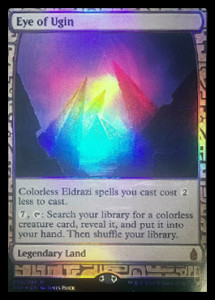
DJ Johnson – This is one of the only Expeditions where I don’t like the art. Maybe its’ just the bad picture angle, but it doesn’t seem like we have any detail as to what’s going on; just a few pointy hedrons in the background converging on a bright glow. I think the Hedron border looks the best on this one out of all of the Expeditions though, just because of how relevant it is with the name and art. $50ish seems fair.
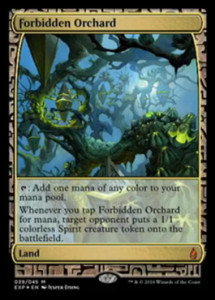
DJ Johnson – Honestly, I didn’t expect this one at all. I don’t think anyone did. Are they going to put Spirit tokens in the Oath packs for one single Expedition out of 20, let alone it probably being the only card in the set that makes colorless non-flying spirit tokens? I’m not sure.
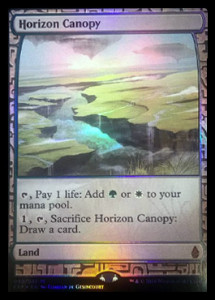
In the recent MTGprice writers podcast, we talked about how it would be awkward for them to put Grove of the Burnwillows in as an Expedition, because it wasn’t part of a complete symmetrical cycle. Well, they proved us wrong in two ways. While Horizon Canopy is still ridiculously expensive, any copies added to the market are sure to be welcomed by Modern players who are looking to play Boggles.

DJ Johnson – In hindsight, the name of this card makes it really, really obvious as an Expedition choice. I really like the art here, with all the clouds and sun and sky and airboat thing. I also had no idea this card was Legendary until right now, so you learn something new every day. The demand for some of these Expeditions may be significantly lower than the previous round, simply because you never see Kor Haven, Strip Mine, or Dust Bowl as more than 1-ofs because they only see play in Commander and other 1-of formats.
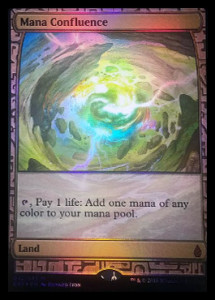
DJ Johnson – I hate to be the guy that complains about an Expedition choice, but really? Why this? Why now? At least the art is cool, so that’s a redeeming factor. I think this will hover in along with the rest of the low-end expeditions, so $45-50.
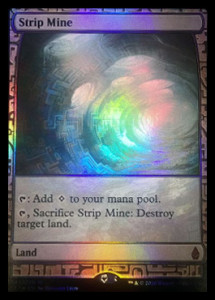
DJ Johnson – Is this supposed to be a shoutout to Commander players as well as Vintage? I have a pretty strong disdain for any deck that’s playing Strip Mine in the 99. FTV Mines are around $25 right now, and I would peg this to hover at the $60-70 range a few weeks after release. They really nailed it with all of the art for each of these.
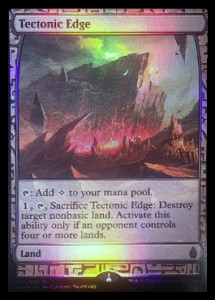
DJ Johnson – Uhhh……. why? I mean, I guess they have a whole “destroy Zendikar” theme going on here with all the land destruction Expeditions, but still. I guess they wanted Tec Edge to support Modern, Strip Mine for Vintage, and Wasteland for Legacy? If we consider that the cheapest Expedition right now can be found for under $40 on TCGplayer (Smoldering Marsh), then I think we can expect Tec Edge to settle down at around $45-50. It’s going to see more Modern play, and people will be more willing to jump onto the Expedition without fear of rotation.

DJ Johnson – And here we arrive at the grand finale. I honestly didn’t expect this to be in the set; part of that was because I didn’t think that they would print one Expedition that was head and shoulders more valuable and desired than the rest, and part of me is concerned for some 9 year old kid who might pull this and confuse it with a regular “Waste land”, then trade it away for the ultimate rip-off. Maybe that’s a non-issue because of the different text and all, but it’s just something to think about. Still, expect these to compete with the Judge foils, because you can’t pull anything better than this. $250 easy, I might even be calling it a bit low.
